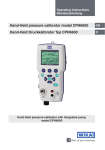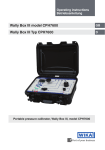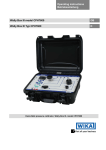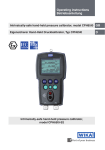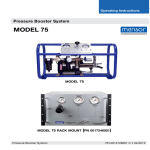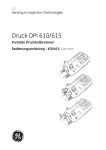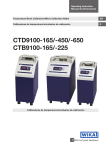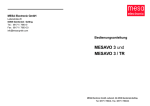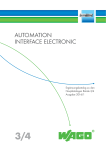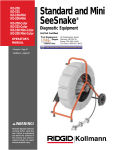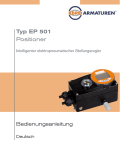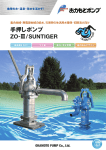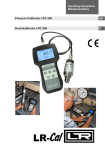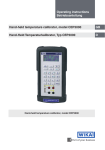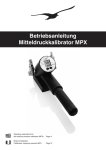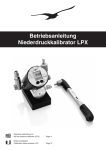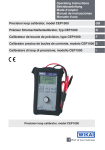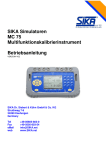Download Hand-Held pressure calibrator model CPH6600 Hand-Held
Transcript
Operating instructions Betriebsanleitung Hand-Held pressure calibrator model CPH6600 GB Hand-Held Druckkalibrator Typ CPH6600 D Hand-Held pressure calibrator with integrated pump, model CPH6600 GB Operating instructions model CPH6600 D Betriebsanleitung Typ CPH6600 Page 3 - 48 Seite 49 - 94 Further languages can be found at www.wika.com. Prior to starting any work, read the operating instructions! Keep for later use! Vor Beginn aller Arbeiten Betriebsanleitung lesen! Zum späteren Gebrauch aufbewahren! 2 WIKA operating instructions, model CPH6600 14005103.03 11/2012 GB/D © 2011 WIKA Alexander Wiegand SE & Co. KG All rights reserved. / Alle Rechte vorbehalten. WIKA® is a registered trademark in various countries. WIKA® ist eine geschützte Marke in verschiedenen Ländern. Contents 14005103.03 11/2012 GB/D Contents 1. General information 2. Safety 2.1 Intended use 2.2 Personnel qualification 2.3 Special hazards 2.4 Labelling/safety marks 3. Specifications 4. Design and function 4.1 Description 4.2 Scope of delivery 4.3 Voltage supply 4.4 CPH6600 hand-held pressure calibrator, pressure and electrical connections 4.5 CPH6600 hand-held pressure calibrator, keypad 5. Transport, packaging and storage 6. Commissioning, operation 6.1 Calibrator display 6.2 Using the backlighting 6.3 Using of the "ZERO" function 6.4 Other menu controlled functions 6.5 Factory settings 6.6 Menu structure 6.7 Basic setup and initial pressure generation 6.8 Measuring pressure 6.9 Measuring and transmitting current (4 ... 20 mA) 6.10 Measuring voltage 6.11 Measuring temperature with a resistance thermometer 6.12 Performing a pressure switch test 6.13 Calibrating transmitters 6.14 MIN/MAX value capture 7. Maintenance, cleaning and recalibration 8. Faults 9. Dismounting, return and disposal 10. Accessories Appendix: EC Declaration of Conformity for model CPH6600 4 5 5 6 7 8 9 13 13 13 13 14 15 16 17 17 20 20 20 25 27 29 30 31 33 34 35 37 42 42 44 45 46 47 Declarations of conformity can be found online at www.wika.com. WIKA operating instructions, model CPH6600 3 GB 1. General information 1. General information ■■ The hand-held pressure calibrator described in the operating instructions has been manufactured using state-of-the-art technology. All components are subject to stringent quality and environmental criteria during production. Our management systems are certified to ISO 9001 and ISO 14001. ■■ These operating instructions contain important information on handling the instrument. Working safely requires that all safety instructions and work instructions are observed. ■■ Observe the relevant local accident prevention regulations and general safety regulations for the instrument's range of use. ■■ The operating instructions are part of the product and must be kept in the immediate vicinity of the instrument and readily accessible to skilled personnel at any time. ■■ Skilled personnel must have carefully read and understood the operating instructions prior to beginning any work. ■■ The manufacturer's liability is void in the case of any damage caused by using the product contrary to its intended use, non-compliance with these operating instructions, assignment of insufficiently qualified skilled personnel or unauthorised modifications to the instrument. ■■ The general terms and conditions contained in the sales documentation shall apply. ■■ Subject to technical modifications. ■■ Factory calibrations / DKD/DAkkS calibrations are carried out in accordance with international standards. ■■ Further information: - Internet address: - Relevant data sheet: - Application consultant: 4 www.wika.de / www.wika.com CT 16.01 Tel.: (+49) 9372/132-9986 Fax: (+49) 9372/132-8767 E-Mail: [email protected] WIKA operating instructions, model CPH6600 14005103.03 11/2012 GB/D GB 1. General information / 2. Safety Explanation of symbols WARNING! ... indicates a potentially dangerous situation that can result in serious injury or death, if not avoided. GB CAUTION! ... indicates a potentially dangerous situation that can result in light injuries or damage to equipment or the environment, if not avoided. Information ... points out useful tips, recommendations and information for efficient and trouble-free operation. 2. Safety WARNING! Before installation, commissioning and operation, ensure that the appropriate hand-held pressure calibrator has been selected in terms of measuring range, design and specific measuring conditions. Non-observance can result in serious injury and/or damage to the equipment. 14005103.03 11/2012 GB/D Further important safety instructions can be found in the individual chapters of these operating instructions. 2.1 Intended use This hand-held pressure calibrator is used as a calibration instrument for various pressure measuring instruments. WIKA operating instructions, model CPH6600 5 2. Safety The instrument has been designed and built solely for the intended use described here, and may only be used accordingly. The technical specifications contained in these operating instructions must be observed. Improper handling or operation of the instrument outside of its technical specifications requires the instrument to be taken out of service immediately and inspected by an authorised WIKA service engineer. Handle electronic precision measuring instruments with the required care (protect from humidity, impacts, strong magnetic fields, static electricity and extreme temperatures, do not insert any objects into the instrument or its openings). Plugs and sockets must be protected from contamination. If the instrument is transported from a cold into a warm environment, the formation of condensation may result in instrument malfunction. Before putting it back into operation, wait for the instrument temperature and the room temperature to equalise. The manufacturer shall not be liable for claims of any type based on operation contrary to the intended use. 2.2 Personnel qualification WARNING! Risk of injury should qualification be insufficient! Improper handling can result in considerable injury and damage to equipment. The activities described in these operating instructions may only be carried out by skilled personnel who have the qualifications described below. Skilled personnel Skilled personnel are understood to be personnel who, based on their technical training, knowledge of measurement and control technology and on their experience and knowledge of country-specific regulations, current standards and directives, are capable of carrying out the work described and independently recognising potential hazards. 6 WIKA operating instructions, model CPH6600 14005103.03 11/2012 GB/D GB 2. Safety 14005103.03 11/2012 GB/D 2.3 Special hazards WARNING! ■■ Do not apply a voltage greater than the specified voltage to the instrument. See chapter 3 "Specifications". ■■ Make sure that the test probes never contact a voltage source while the test cables are connected to the current terminals. ■■ Do not use the calibrator if it is damaged. Before using the instrument, check that there are no cracks or missing plastic parts on the case. Pay particular attention to the insulation of the connectors. ■■ Select the proper function and correct measuring range for the measurement. ■■ The battery cover must be closed and locked in place before the calibrator is operated. ■■ Remove the test cables from the instrument before opening the battery compartment. ■■ Inspect the test cables for damaged insulation or exposed metal. Check the continuity of the test leads. Damaged test leads should be replaced before using the instrument. ■■ When using test probes keep fingers away from the test probe contacts. Keep your fingers behind the test probes' finger guards. ■■ First connect the common lead, and then the live lead. When disconnecting, remove the live test lead first. ■■ Do not use the instrument if it is not working properly. The instrument protection might be compromised. If in doubt, have the instrument checked. ■■ Do not operate the instrument in areas with explosive gases, vapours or dust. ■■ When measuring pressure, make sure that the process pressure line is shut off and depressurised before it is connected to or disconnected from the pressure module. ■■ Disconnect test leads before changing to another measurement or generation function. ■■ To avoid false readings, which could lead to possible electric shock or personal injury, replace the battery as soon as the battery indicator appears. ■■ In order to avoid any possible damage to the instrument or the test equipment, use the correct leads, the correct function and the correct range for the measuring application. WIKA operating instructions, model CPH6600 7 GB 2. Safety WARNING! ■■ When screwing an adapter to the NPT thread of the calibrator, it is necessary to use an additional sealing compound (e.g. Teflon tape). GB ■■ When screwing use a wrench at the pressure port to fix the calibrator and avoid unnecessary stress to the case. 2.4 Labelling/safety marks Product label Explanation of symbols Before mounting and commissioning the instrument, ensure you read the operating instructions! CE, Communauté Européenne Instruments bearing this mark comply with the relevant European directives. 8 WIKA operating instructions, model CPH6600 14005103.03 11/2012 GB/D This marking on the instruments indicates that they must not be disposed of in domestic waste. The disposal is carried out by return to the manufacturer or by the corresponding municipal authorities (see directive 2002/96/EC). 3. Specifications 3. Specifications Measuring range GB Pressure Relative pressure -0.8 ... +2 bar -0.8 ... +10 bar -0.8 ... +20 bar Overpressure safety 4 bar 13 bar 40 bar Burst pressure 20 bar 20 bar 135 bar Absolute pressure 0 ... 2 bar abs. 0 ... 10 bar abs. Overpressure safety 4 bar abs. 13 bar abs. Burst pressure 20 bar abs. 20 bar abs. Accuracy 0.025 % FS Resolution 5-digit Current Measuring range 0 … 24 mA (max. load 1,000 Ω) Resolution 1 µA Accuracy 0.015 % of reading ±2 µA (simulation and measurement) Voltage Measuring range DC 0 … 30 V Resolution 1 mV Accuracy 0.015 % of reading ±2 mV (measurement) 14005103.03 11/2012 GB/D Temperature Measuring range -40 … +150 °C Resolution 0.01 °C Accuracy 0.015 % of reading ±20 mΩ, or 0.2 °C for complete measuring chain (Pt100 resistance thermometer and CPH6600) WIKA operating instructions, model CPH6600 9 3. Specifications Basic instrument Pressure connection 1/8 NPT female Temperature compensation 15 … 35 °C Permissible media Temperature coefficient Units Output Supply voltage clean, dry, non-corrosive gases compatible with silicon, Pyrex, RTV, gold, ceramic, nickel and aluminium 0.005 % of the span/°C outside of 15 ... 35 °C psi, bar, mbar, kPa, MPa, kg/cm², mmH2O (4 °C), mmH2O (20 °C), cmH2O (4 °C), cmH2O (20 °C), inH2O (4 °C), inH2O (20 °C), inH2O (60 °F), mmHg (0 °C), inHg (0 °C) DC 24 V Power supply Batteries Battery life 1) DC 12 V, eight AA batteries 125 pump cycles to 20 bar 300 pump cycles to 10 bar 1,000 pump cycles to 2 bar Permissible ambient conditions Operating temperature -10 … +50 °C Storage temperature -20 … +60 °C Relative humidity 35 ... 85 % relative humidity (no condensation) 1) Minimum information for the included batteries. Case Material Blend of polycarbonate and ABS Dimensions 103.3 x 229.0 x 70.7 mm Weight 950 g Approvals and certificates EC conformity EMC directive Certification Calibration 2004/108/EC, EN 61326 Emission (Group 1, Class B) and Immunity (portable measurement equipment) 3.1 calibration certificate per DIN EN 10204 optional: DKD/DAkkS calibration certificate For further specifications see WIKA data sheet CT 16.01 and the order documentation. 10 WIKA operating instructions, model CPH6600 14005103.03 11/2012 GB/D GB 3. Specifications Available ranges and resolution 14005103.03 11/2012 GB/D Pressure range and factor Relative pressure -0.8 ... +2 bar -0.8 ... +10 bar -0.8 ... +20 bar Overpressure safety 4 bar 13 bar 40 bar Burst pressure 20 bar 20 bar 135 bar Unit conversion factor psi 1 30.000 150.00 300.00 bar 0.06894757 2.0684 10.3421 20.684 mbar 68.94757 2,068.4 10,342.1 20,684 kPa 6.894757 206.84 1,034.21 2,068.4 MPa 0.00689476 0.2068 1.03421 2.0684 kg/cm² 0.07030697 2.1092 10.5460 21.092 cmH2O (4 °C) 70.3089 2,109.3 10,546.3 21,093 cmH2O (20 °C) 70.4336 2,113.0 10,565.0 21,130 mmH2O (4 °C) 703.089 21,093 - - mmH2O (20 °C) 704.336 21,130 - - inH2O (4 °C) 27.68067 830.42 4,152.1 8,304.2 inH2O (20 °C) 27.72977 831.89 4,159.5 8,318.9 inH2O (60 °F) 27.70759 831.23 4,156.1 8,312.3 mmHg (0 °C) 51.71508 1,551.5 7,757.3 15,515 inHg (0 °C) 2.03602 61.081 305.40 610.81 WIKA operating instructions, model CPH6600 11 GB 3. Specifications Dimensions in mm Side view, right Side view, left 12 WIKA operating instructions, model CPH6600 14005103.03 11/2012 GB/D GB Front view 4. Design and function 4. Design and function 4.1 Description The CPH6600 has been designed so that it is both an easy-to-use and also a very flexible pressure calibrator. The internal pressure sensor combined with an innovative electrical pump and inputs for current, voltage, switch contacts and a resistance thermometer enable the CPH6600 to calibrate virtually any pressure instrument. An optional external pressure module allows an even greater pressure range, including both absolute pressure and differential pressure calibration. 4.2 Scope of delivery ■■ Hand-held pressure calibrator with integrated pump, model CPH6600 ■■ Operating instructions ■■ Test cables ■■ Calibration hose with ⅛ NPT male thread connections ■■ Adapter set consist of: - ⅛ NPT female to ¼ NPT female - ⅛ NPT female to ¼ BSP female - ⅛ NPT female to G ½ female ■■ PTFE thread seal tape ■■ Eight AA batteries ■■ 3.1 calibration certificate per DIN EN 10204 Cross-check scope of delivery with delivery note. 4.3 Voltage supply 14005103.03 11/2012 GB/D Replacing batteries To avoid false measurements, replace the batteries as soon as the battery indicator comes on. If the batteries run too low the instrument will automatically shut down to avoid the batteries leaking. Only AA size alkaline batteries or rechargeable batteries, from the optional hand-held pressure calibrator model CPH6600 accessories, should be used. WIKA operating instructions, model CPH6600 13 GB 4. Design and function 4.4 CPH6600 hand-held pressure calibrator, pressure and electrical connections Side view, right Side view, left CPH6600 6 7 F1 F2 F3 ZERO 5 5 HOME PUMP 4 4 3 1 2 Rear 1 2 3 4 5 9 8 6 7 8 9 14 Electrical connection current, voltage, switch test Fine pressure adjustment Pressure connection Vent rotating knob ○ = open / ● = closed Pressure/Vacuum rotating selection knob + = Pressure / - = Vacuum Connection for external pressure module Connection for resistance thermometer Connection for Firmware programming (only manufacturer) Pump purge valve WIKA operating instructions, model CPH6600 14005103.03 11/2012 GB/D GB Front view 4. Design and function 4.5 CPH6600 hand-held pressure calibrator, keypad GB 1 F1 F2 F3 3 ZERO HOME 4 2 5 PUMP 6 1) Function keys Configuration of the instruments 2) ON/OFF key Turning the instrument on and off 3) ZERO key Zeroing of the pressure measurement 4) Arrow keys Control of the current source/current simulation and adjustment of the pump limit and the %-error limit 5) HOME key Return to main menu 14005103.03 11/2012 GB/D 6) Pump key Start-up of the pump operation WIKA operating instructions, model CPH6600 15 5. Transport, packaging and storage 5. Transport, packaging and storage 5.1 Transport Check hand-held pressure calibrator for any damage that may have been caused by transport. Obvious damage must be reported immediately. 5.2 Packaging Do not remove packaging until just before use. Keep the packaging as it will provide optimum protection during transport (e.g. change in installation site, sending for repair). 5.3 Storage Permissible conditions at the place of storage: ■■ Storage temperature: -20 ... +60 °C ■■ Humidity: 35 ... 85 % relative humidity (no condensation) Avoid exposure to the following factors: ■■ Direct sunlight or proximity to hot objects ■■ Mechanical vibration, mechanical shock (putting it down hard) ■■ Soot, vapour, dust and corrosive gases ■■ Potentially explosive environments, flammable atmospheres Store the hand-held pressure calibrator in its original packaging in a location that fulfils the conditions listed above. If the original packaging is not available, pack and store the instrument as described below: 1. Wrap the instrument in an antistatic plastic film. 2. Place the instrument, along with shock-absorbent material, in the packaging. 3. If stored for a prolonged period of time (more than 30 days), place a bag, containing a desiccant, inside the packaging. 16 WIKA operating instructions, model CPH6600 14005103.03 11/2012 GB/D GB 6. Commissioning, operation 6. Commissioning, operation As soon as the hand-held pressure calibrator is turned on, by pressing the ON/OFF key, it will go through a short self-test routine. During that routine, the display shows the current firmware version, auto-shutdown status and the range of the internal pressure sensor. The calibrator requires a maximum of 5 minutes warm-up to reach its specified accuracy. Large changes in ambient temperature may make a longer warm-up period necessary. The calibrator should be zeroed before starting the calibration. 6.1 Calibrator display The calibrator's display consists of two sectors: The menu bar (located along the bottom of the screen) is used to access the menu system. The main display (the rest of the display) consists of up to three sub-sectors for the measurement activities. These sub-sectors will be referred to as the UPPER, MIDDLE and LOWER displays in this document. Figure 1 shows the location of the different display fields, while are discribed in the following table. 1 4 2 3 Figure 1: Display 1 14005103.03 11/2012 GB/D 2 3 4 Pressure units Indication of the pressure unit (selectable from 15 pressure units) Units Indication of the measuring unit Display of the span Indication of the 4 ... 20 mA span (only for the functions mA and mA current loop) Primary parameter Indication of the current measured parameters WIKA operating instructions, model CPH6600 17 GB 6. Commissioning, operation 6.1.1 Main display functionality There are three options for this menu: "MENU", {active display}, and "LIGHT". GB 6.1.1.1 Using the "MENU" option The "MENU" option is entry to the rest of the menu system. 6.1.1.2 Using the {active display} option The {active display} is displayed via the middle option in the menu in the main display. It is used to select which display on the screen, for example, the ZERO key will be used for. 6.1.1.3 Using the "LIGHT" option The backlight can be toggled on and off using this key. 6.1.2 Main menu Functionality There are three options on the menu, "CONFIG", {active display} and "MORE". The main menu is the 'home' for the menu display. 6.1.2.1 Setting the {active display} The {active display} is displayed via the middle option in the menu in the main display. Pressing the F2 key switches between the {active display}. Here the "SELECT" option will switch between the available choices for each parameter. The first parameter is "MODE". Since voltage, current and switch test modes all use the same leads, two of these functions cannot be used concurrently. The ability 18 WIKA operating instructions, model CPH6600 14005103.03 11/2012 GB/D 6.1.2.2 Setting the {active display} parameters In order to set the {active display} parameters, select the "CONFIG" option and open the configuration menu. 6. Commissioning, operation to select certain functions is limited and dependent upon what is already selected in the other display sector. The "NEXT" option is used to change to the second parameter. Only the resistance thermometer and pressure modes have a second parameter. Resistance thermometers can be displayed in Celsius or Fahrenheit and for pressure there are 11 different units. Within any single display sector, the following modes are available: P[1] = integrated pressure sensor [EXT] = pressure with external pressure module P[1] ST = switch test with integrated sensor [EXT] ST = switch test with external pressure module Current functions are only available on the lower display: mA measurement = current measurement without voltage supply mA w/24V = current measurement with voltage supply mA Source = current source mA sim = mA simulation using an external supply from the instrument under test VOLT = voltage measurement RTD = resistance thermometer (in the event a resistance thermometer is connected) The following table shows which functions are available concurrently. An "--" in a column indicates that the mode in the active display will not be available for selection if the mode in that row is in use in any other display sector. 14005103.03 11/2012 GB/D Other displays P[1] P[1] [EXT] P[1] ST [EXT] ST mA mA-loop Volt RTD Active display P[1] [EXT] [EXT] ST ST -- -- -- -- -- mA mA-loop Volt RTD -- -- --- - ---- 6.1.2.3 Accessing other menus In order to access further menus, select the "MORE" option in the main menu. WIKA operating instructions, model CPH6600 19 GB 6. Commissioning, operation 6.3 Using the "ZERO" function When the ZERO key is pressed, the calibrator will zero the {active display}, as long as a pressure mode is selected and the pressure is within the zero limit. The zero limits are within 5 % of the full scale range of the selected sensor. If the display indicates "OL" the zero function will not operate. The ZERO key is only used for pressure. 6.3.1 External pressure module (not absolute) When a pressure module is selected in the {active display} and the ZERO key is pressed, the calibrator subtracts the current displayed reading from the output value. The zero limits are within 10 % of the full scale range of the selected sensor. If the display indicates "OL" the zero function will not operate. 6.3.2 External pressure module (absolute) When an external absolute pressure module is selected in the {active display} and the ZERO key is pressed, the calibrator prompts the user to enter the barometric reference pressure. For this the arrow keys can be used. The sensor port should be opened (vented) to atmosphere while performing this procedure. 6.4 Other menu controlled functions There are 12 sub-menus that can be accessed through the "MORE" option of the main menu. A sub-menu contains three options. The first option is unique to this function. The second and third options of a sub-menu are always the same. The "NEXT" option leads to the next sub-menu and the "DONE" option returns to home. 20 WIKA operating instructions, model CPH6600 14005103.03 11/2012 GB/D GB 6.2 Using the backlighting The backlight is controlled by the "LIGHT" option on the main menu. The light is toggled on and off when the F3 key is pressed. 6. Commissioning, operation For the last sub-menu the "NEXT" option wraps around to home. The detailed menu structure can be found in chapter 6.6 "Menu structure". Note on naming: If a 'sub-menu' has further subdivisions, from now on it will be referred to as {function} main menu. The "CONTRAST" sub-menu for example will be referred to as the "CONTRAST" main menu. Otherwise it will be referred to as the {function} menu. 6.4.1 Setting the contrast From the CONTRAST main menu, choose the "CONTRAST" option in order to access the "Setting the contrast" menu. Use the F2 and F3 keys to set the display contrast to the desired level and then use the "CONTRAST DONE" option to return home. 14005103.03 11/2012 GB/D 6.4.2 Locking and unlocking configurations Use the "LOCK CFG" or "UNLOCK CFG" option of the configuration lock menu respectively to lock or unlock the display configuration. When the "LOCK CFG" option is chosen, the menu display returns home and the "CONFIG" option on the main menu indicates that it is locked. Also, all other menus are locked with the exception of the "MIN/MAX", "Setting the contrast" and "UNLOCK CFG" menus. When the "UNLOCK CFG" option is chosen, the configuration is unlocked and the menu display continues to the next sub-menu. WIKA operating instructions, model CPH6600 21 GB 6. Commissioning, operation "SAVE" to save the setting, "RECALL" to recall the setting or "DONE" to return home. If "SAVE" or "RECALL" is selected, use the arrow keys to select the setting location. Then use the "SAVE" option to store the current setting into the selected location or the "RECALL" option to recall the setting stored in the selected location. The display menu will automatically return home. 6.4.4 Setting auto shut-off parameters The calibrator will switch itself off after a specified time; this function can also be deactivated. Use the "AUTO OFF" option to set the auto shut-off parameters. Use the F2 and F3 keys to select the time after which the calibrator will turn itself off, or disable the auto shut-off by scrolling down to "0". 22 WIKA operating instructions, model CPH6600 14005103.03 11/2012 GB/D GB 6.4.3 Saving and recalling settings The calibrator automatically saves the current setting for recall on power-up. In addition, five settings can be accessed through the "SETUPS" menu. Select the "SETUPS" option from the sub-menu. 6. Commissioning, operation Use the "AUTO OFF DONE" option to set the parameters and return home. The auto shut-off time is reset whenever a key is pressed. GB 6.4.5 Activating and deactivating a display Use the "DISPLAY" option on the 'Display selection' main menu to access the display activation menu. The F2 key can be used to select the desired display. The "ON/OFF" option switches the active display on or off. The active display and the current status "ON/OFF" are shown in the lower display. 14005103.03 11/2012 GB/D Select the "DONE" option to save the changes and return home. When a display is deactivated its configuration is retained. As soon as the display is activated, the configuration is checked against the configurations of the other currently-active displays. If there is any conflict between configurations, the recalled display’s configuration is modified to avoid the conflict. If all three displays are deactivated the lower display will switch on automatically. 6.4.6 Setting the resistance thermometer probe Use the "PROBE TYPE" option of the 'RTD Probe Type' main menu to access the menu for resistance thermometer probe selection. WIKA operating instructions, model CPH6600 23 6. Commissioning, operation The default resistance thermometer type is "P100-385" (Pt100-385). 6.4.7 Damping Damping can be turned ON or OFF using the damping menu selection. As soon as the damping function is switched ON, the calibrator displays the running average of the last ten measurements. The calibrator makes approximately three readings per second. 6.4.8 Pump limit To prevent overpressuring for sensitive test item, a maximum pressure (pump limit) can be set. In this mode, use the arrow keys to set the maximum pressure. 6.4.9 HART™ Resistor An internal 250 Ω HART™ resistor can be enabled when the calibrator is operated in the "mA measure-24V" mode. This allows a HART Communicator to be connected across the mA terminals and eliminates the need for adding an external resistor. When the HART™ resistor is enabled, the maximum load driving capability is 750 Ω. 24 WIKA operating instructions, model CPH6600 14005103.03 11/2012 GB/D GB There are four types of resistance thermometers: "P100-385", "P100-392", "P100-JIS" and "CUSTOM". With "CUSTOM", custom resistance thermometers can be selected. Use the "SELECT" option to select the desired probe type and the "DONE" option to store the change and return home. 6. Commissioning, operation 6.5 Factory settings The calibrator is delivered with five commonly-used factory settings. These settings are shown below. GB Any of these settings can be changed and saved by the user. Setting 1: The upper display is set to [P1] mode and the lower is set to "mA"; the middle is off. 14005103.03 11/2012 GB/D Setting 2: The upper display is set to [P1] mode and the lower is set to "RTD"; the middle is off. WIKA operating instructions, model CPH6600 25 6. Commissioning, operation Setting 4: The lower display is set to [P1] "SWITCH TEST" all other displays are off. Setting 5: The upper display is set to [P1], the middle display is set to [EXT] and the lower display is set to "RTD". 26 WIKA operating instructions, model CPH6600 14005103.03 11/2012 GB/D GB Setting 3: The upper display is set to [P1] mode, the middle is set to "RTD" and the lower is set to "mA". 6. Commissioning, operation 6.6 Menu structure 14005103.03 11/2012 GB/D GB WIKA operating instructions, model CPH6600 27 6. Commissioning, operation 28 WIKA operating instructions, model CPH6600 14005103.03 11/2012 GB/D GB 6. Commissioning, operation 6.7 Basic Setup and initial pressure generation 1. The CPH6600 is supplied with a special low-volume calibration hose to enable faster pressure generation and quick pressure stabilisation. Included in delivery are "Quick-fit" hose connectors and various adapters. It is recommended that this hose is used in order to achieve the best results. As soon as the fittings are installed and the calibrator is connected to the test item the calibrator is ready for use. Figure 5 in chapter 6.13.2 "Calibrating a pressure-to-current transmitter" shows a typical setting. 2. The pressure calibrator must be configured for the appropriate application (see chapter 6). 3. Set the pressure/vacuum selection knob to the desired function (+ for pressure and for vacuum). 4. Close the vent knob. 5. Press the pump key and monitor the pressure rise (or vacuum generation) until you reach the desired pressure. On the electric pump version the motor speed will start slowly while the pressure is low (< 1 bar) to enable better control at low pressures. 6. The fine pressure adjustment enables the pressure to be set precisely. 7. To reduce or bleed off the pressure entirely slowly rotate the vent knob to the open position. The pressure reduction is best controlled if this step is carried out carefully and it makes reading the pressure easier. 14005103.03 11/2012 GB/D 6.7.1 Electrical pump The CPH6600 incorporate a small, lightweight, battery-powered pneumatic pump that enables the user to build a relatively high pressure of up to 20 bar, quickly and with good control. Since this pump has an upper limit of 21 bar, there may be atmospheric conditions where the full pressure of 20 bar cannot be achieved. High altitudes (around 3,000 ft. or 1,000 metres) or operation in cold temperatures could limit the pump to 19 bar. In these cases, the fine pressure adjustment can be used to generate additional pressure, should the full range be required. In these situations the user should begin the calibration with the fine pressure adjustment knob in the full anti-clockwise position and then, when the electric pump reaches its limit, turn the fine pressure adjustment knob in the clockwise direction to raise the pressure and to set the desired value. WIKA operating instructions, model CPH6600 29 GB 6. Commissioning, operation CAUTION! Pressure sensors may be damaged and/or injuries may occur to the personnel due to improper application of pressure. For a better understanding with respect to overpressure and burst pressure, follow the specifications laid down in these operating instructions (see chapter 3 "Specifications"). The calibrator display will indicate "OL" when an inappropriate pressure is applied. As soon as "OL" is observed on any pressure display, the pressure should be reduced immediately to prevent damage or possible physical injury. "OL" is displayed if the pressure exceeds the nominal range by 110 %. Use the ZERO key to zero the pressure sensor once it is vented to atmospheric pressure. 6.8.1 Media compatibility The CPH6600 has a unique valve-cleaning port. This is to make the pump more accessible for the user, and thus easier to maintain. Chapter 7.2 "Cleaning" describes the cleaning of these valves. Even though servicing the pump is easy, care should be taken that the calibrator is only used with clean, dry gases. CAUTION! The calibrator should only be used with clean, dry gases! To prevent contamination by the test pieces, the use of a dirt trap is recommended (see chapter 10 "Accessories")! 30 WIKA operating instructions, model CPH6600 14005103.03 11/2012 GB/D GB 6.8 Measuring pressure For pressure calibration, connect the calibrator with an appropriate adapter. Select the pressure setting for the display being used. The calibrator is equipped with an internal pressure sensor and optional external pressure modules are available. Choose a sensor that is suitable for the pressure range and accuracy. 6. Commissioning, operation 6.8.2 Measuring pressure with external modules The calibrator has a digital interface for external pressure modules. These modules are available for various ranges, including gauge, vacuum, differential and absolute pressure. The modules work seamlessly in conjunction with the calibrator. Simply plug them into the interface and select [EXT] (external sensor). Since the interface between the calibrator and the module is digital, the accuracy and display resolution is dependent on the pressure module. Valve Pressure module adapter Pressure module 14005103.03 11/2012 GB/D Figure 2: Pressure measurement with external pressure module 6.9 Measuring and sourcing current (4 ... 20 mA) 1. To measure current, use the input terminals on the front of the calibrator. Select the mA function on the lower display. Current is measured in mA and percentage of the measuring range. The measuring range on the calibrator is set to 0 % at 4 mA and 100 % at 20 mA. WIKA operating instructions, model CPH6600 31 GB 6. Commissioning, operation Example: If the current measured is displayed as 75 %, then the value is 16 mA. GB The display will indicate "OL" when the measured current exceeds the nominal range of current measurement (24 mA). 2. The same connections are used for the current source. Select mA-Source or mA Sim-2W from the configuration display. 3. This selection can only be made in the lower display. Also, in source mode, the calibrator will generate 0 ... 24 mA using its own internal DC 24 V supply, whereas in simulation mode the calibrator acts as a 2-wire transmitter and requires an external DC 24 V supply. 4. Pressing any of the arrow keys will start the output mode and enable you to use the arrow keys to adjust the mA output. The function keys can also be used to progress the output in either 25 % steps (4, 8, 12, 16, 20 mA) or 0 % (4 mA) and 100 % (20 mA). 5. While in the mA output mode, if the loop is broken or the value is exceeded, the calibrator will flash "OL". 4 ... 20 mA 32 Test item Test item WIKA operating instructions, model CPH6600 14005103.03 11/2012 GB/D 4 ... 20 mA 6. Commissioning, operation Test item GB 4 ... 20 mA Voltage supply DC 24 V 4 ... 20 mA Test item 6.10 Measuring voltage For voltage measurement, use the connections on the front of the calibrator. Select the VOLTS function on one of the displays. The calibrator can measure up to DC 30 V. The display will indicate "OL" when the measured voltage exceeds the nominal range of voltage (30 V). 14005103.03 11/2012 GB/D Up to DC 30 V WIKA operating instructions, model CPH6600 Test item 33 6. Commissioning, operation The factory default type is "P100-385", so if the CPH6600 is being used with a WIKA Pt100 you do not have to reset the resistance thermometer type. The WIKA Pt100 only needs to be connected to the CPH6600 and the measured temperature will immediately be displayed. The display will indicate "OL" if the measured temperature is outside the nominal measurement range of the resistance thermometer (below -40 °C or above 150 °C). If a custom resistance thermometer is being used, the entry of R0 and the coefficients is handled through the serial interface. Figure 3: CPH6600 with a resistance thermometer 34 WIKA operating instructions, model CPH6600 14005103.03 11/2012 GB/D GB 6.11 Measuring temperature with a resistance thermometer For temperature measurement, select the function "RTD" on one of the displays. The correct resistance thermometer must be used. There are four types of resistance thermometer supported: "P100-385", "P100-392", "P100-JIS" and "CUSTOM". 6. Commissioning, operation 6.12 Performing a pressure switch test GB Pressure switch Use low volume hose if possible Figure 4: CPH6600 with pressure switch To perform a switch test, the following steps must be taken: 1. Switch to SETUP 4 (standard switch test). SETUP 4: The upper display is set to [P1] ST, all other displays are switched off. 14005103.03 11/2012 GB/D The pressure switch test can be performed with the following functions [P1] ST or EXT ST. 2. Connect the calibrator to the pressure switch using the switch terminals. The polarity of the terminals does not matter. Then connect the pressure side of the calibrator and the pressure switch. 3. Open the vent key on the pump and zero the calibrator. Then close the vent after resetting the calibrator. WIKA operating instructions, model CPH6600 35 6. Commissioning, operation 4. The top of the display will indicate "CLOSE". GB 5. Apply pressure with the pressure side slowly until the pressure switch opens. In the switch test mode the display update rate is increased to help capture changing pressure inputs. Even with this accelerated sample rate the device under test should be charged slowly with pressure in order to ensure accurate readings. 6. Once the switch is open, "OPEN" will be displayed; bleed the pump slowly until the pressure switch closes. 36 WIKA operating instructions, model CPH6600 14005103.03 11/2012 GB/D 7. In the top display it will now read "SW OPENED AT" and give you the pressure at which the switch opened. 6. Commissioning, operation 8. Select the "NEXT" option to display the pressure at which the switch closed and the hysteresis "SW DEADBAND". GB 9. Select the "NEW TEST" option to clear the data and perform another test. 10.Select the "DONE" option to end the test and return to the standard pressure setting. Example: [P1] ST will return to [P1]. The previous example uses a normally closed switch. The basic procedure is effectively the same for a normally open switch, the display will simply read "OPEN" instead of "CLOSE". 6.13 Calibrating transmitters 14005103.03 11/2012 GB/D 6.13.1 Using the mA measurement function The mA function enables the user to read out the 4 ... 20 mA output from the instrument being calibrated. This can be done in two ways. 1) Passively – the test item generates 4 ... 20 mA directly. The value is read on the calibrator. 2) Actively – the calibrator supplies a voltage supply of DC 24 V to the test item to power the device while reading the resulting 4 ... 20 mA signal. Passive WIKA operating instructions, model CPH6600 Active 37 6. Commissioning, operation Use low volume hose if possible Figure 5: CPH6600 with a pressure transmitter 38 WIKA operating instructions, model CPH6600 14005103.03 11/2012 GB/D GB 6.13.2 Calibrating a pressure-to-current transmitter To calibrate a pressure-to-current transmitter (P/I), perform the following: 1. Connect the calibrator and the pump to the transmitter. 2. Pressurise the transmitter via the calibrator. 3. Measure the current output of the transmitter. 4. Ensure that the read value is correct. If it isn't, the transmitter must be adjusted. 6. Commissioning, operation 6.13.3 %-Error function The calibrator features a special function which can calculate the error in the pressure value from the mA value as a percentage of the 4 ... 20 mA span. The %-Error mode uses all three screens and has a special menu structure. It displays pressure, mA and %-Error simultaneously. 14005103.03 11/2012 GB/D Figure 6: CPH6600 with a pressure transmitter with %-Error function Example: Suppose a pressure transmitter under test has a full scale range (measuring range) of 20 bar and gives a corresponding 4 ... 20 mA output signal. The user can programme in a 0 ... 20 bar pressure span into the calibrator and the calibrator will then calculate and display the deviation or %-Error value from the 4 ... 20 mA output. This then eliminates manual calculations of the test item deviation. WIKA operating instructions, model CPH6600 39 GB 6. Commissioning, operation 4. "LOOP POWER" (voltage supply) can be toggled on or off; select "NEXT" when done. 5. Use "SELECT" to scroll through the "UNIT" options, and select "NEXT" to move on. 40 WIKA operating instructions, model CPH6600 14005103.03 11/2012 GB/D GB To use the "%-ERROR" function, perform the following: 1. Once the calibrator is switched on and operating, press the F3 key to activate the "MORE" menu option. Then press the F1 key to activate the "%-ERROR" option. 2. Press the F1 key to select the "CONFIG" option. 3. The first option is the port setting. Use the "SELECT" option to scroll through the choice of ports (pressure connections). Once this is completed, select the "NEXT" option. 6. Commissioning, operation 6. Use the arrow keys to set the upper limit of the measuring range; select "DONE SET" when finished. GB 7. Use the arrow keys to set lower limit of the measuring range, and select "DONE SET" when finished. The "%-ERROR" mode will be ready to use. 14005103.03 11/2012 GB/D The lower and upper limit of the measuring range will be saved in non-volatile memory until they are changed again by the user for the internal pressure sensor and the external pressure modules. WIKA operating instructions, model CPH6600 41 6. Commissioning, operation / 7. Maintenance, cleaning, ... To clear the "MIN/MAX" registers, simply press the "CLEAR" key. These registers are also cleared on power-up or when the configuration is changed. 7. Maintenance, cleaning, and recalibration 7.1 Maintenance Repairs must only be carried out by the manufacturer. Replacing the batteries To avoid false measurements, replace the batteries as soon as the battery indicator comes on. If the batteries run too low the CPH6600 will automatically shut down to avoid the batteries leaking. Only AA size alkaline batteries or rechargeable batteries, from the optional CPH6600 accessories, should be used. CAUTION! To avoid personal injury or damage to the calibrator, only use accessories supplied by WIKA and ensure that no water finds its way into the case. 42 WIKA operating instructions, model CPH6600 14005103.03 11/2012 GB/D GB 6.14 MIN/MAX memory The calibrator has a MIN/MAX function for capturing the minimum and maximum values of any displayed parameter. The MIN/MAX function can be set by stepping through the menu options until "MIN/ MAX" is shown on the display above the F1 key. At this point, pressing the F1 key will scroll the display through the MIN/MAX values that are stored in the "MIN/MAX" registers. These readings are live so new MIN/MAX values will be recorded while in this mode. 7. Maintenance, cleaning, and recalibration 7.2 Cleaning 14005103.03 11/2012 GB/D CAUTION! ■■ Before cleaning, vent and switch off the hand-held pressure calibrator. ■■ In order not to damage the display or case, do not use any solvent or scouring agents for cleaning. ■■ Clean the instrument with a moist cloth. ■■ Electrical connections must not come into contact with moisture. Cleaning the valves Occasionally, the CPH6600 might not work properly due to dirt or other contamination in the internal valve assembly. Use the following procedure for cleaning the valve assembly. If this procedure does not fix the problem, the instrument should be sent back for repair. 1. Use a small screwdriver to remove the two valve protection caps in the battery compartment (see chapter 4.4 "CPH6600 hand-held pressure calibrator, pressure and electrical connections"). 2. After the caps have been removed, gently remove the spring and the O-ring 3. Place the valve components in a safe area and clean out the valve body using a cotton swab (standard accessory) soaked in isopropyl alcohol. 4. Repeat the process several times, using a new cotton swab each time, until there is no remaining evidence of contamination. 5. Operate the pump several times and recheck the valve body for contamination. 6. Clean the O-ring assembly and the O-ring on the retention caps with isopropyl alcohol and check the O-rings closely for any damage or excessive wear. If necessary, replace the O-rings. 7. Inspect the springs for wear or loss of tension. They should be approximately 8.6 mm long in the relaxed state. If they are shorter, they may not be able to provide sufficient sealing force. If required, replace them. 8. Once all components have been cleaned and checked, reinstall the O-ring and spring assembly into the valve body. 9. Place the retaining caps back in position and carefully tighten them. 10.Close the output port and operate the pump to at least 50 % of its capacity. 11.Release the pressure and repeat several times to ensure that the O-ring is seated correctly. For information on returning the instrument see chapter 9.2 "Return". WIKA operating instructions, model CPH6600 43 GB 7. Maintenance, cleaning, and service / 8. Faults 7.3 Recalibration 8. Faults Display Reason Measures Low battery power, device will Replace battery only work for a short while longer OL -OL Well above or below the limits of the measuring range Battery flat No display or strange symbols, device is not System error responding to input Technical fault Check: is the pressure within the permissible measuring range of the sensor? --> Reduce the applied pressure Replace battery Switch off the instrument, wait for a short period of time, switch on again Return to manufacturer for repair CAUTION! If faults cannot be eliminated by means of the measures listed above, the hand-held pressure calibrator must be shut down immediately, and it must be ensured that pressure and/or signal are no longer present, and it must be prevented from being inadvertently put back into service. In this case, contact the manufacturer. If a return is needed, please follow the instructions given in chapter 9.2 "Return". 44 WIKA operating instructions, model CPH6600 14005103.03 11/2012 GB/D GB DKD/DAkkS certificate - Certificates: We recommend that the instrument is regularly recalibrated by the manufacturer, with time intervals of approx. 12 months. Every factory recalibration includes, additionally, an extensive free-of-charge check of all system parameters with respect to their compliance with the specification. The basic settings will be corrected if necessary. 9. Dismounting, return and disposal 9. Dismounting, return and disposal WARNING! Residual media in the dismounted instrument can result in a risk to persons, the environment and equipment. Take sufficient precautionary GB 9.1 Dismounting Only disconnect the hand-held pressure calibrator once the system has been depressurised! 9.2 Return WARNING! Strictly observe the following when shipping the instrument: All instruments delivered to WIKA must be free from any kind of hazardous substances (acids, bases, solutions etc.). When returning the instrument, use the original packaging or a suitable transport package. To avoid damage: 1. Wrap the instrument in an antistatic plastic film. 2. Place the instrument, along with the shock-absorbent material, in the packaging. Place shock-absorbent material evenly on all sides of the transport packaging. 3. If possible, place a bag, containing a desiccant, inside the packaging. 4. Label the shipment as transport of a highly sensitive measuring instrument. 14005103.03 11/2012 GB/D Information on returns can be found under the heading "Service" on our local website. 9.3 Disposal Incorrect disposal can put the environment at risk. Dispose of instrument components and packaging materials in an environmentally compatible way and in accordance with the country-specific waste disposal regulations. WIKA operating instructions, model CPH6600 45 10. Accessories This marking on the instruments indicates that they must not be disposed of in domestic waste. The disposal is carried out by return to the manufacturer or by the corresponding municipal authorities (see EU directive 2002/96/EC). GB 10. Accessories Voltage supply ■■ Battery set, consisting of four rechargeable AA batteries ■■ Battery charger set, consisting of four rechargeable AA batteries, quick charger, power cord, adapter set 46 WIKA operating instructions, model CPH6600 14005103.03 11/2012 GB/D Miscellaneous ■■ Dirt trap ■■ Pt100 resistance thermometer ■■ Service case ■■ DKD/DAkkS certified accuracy of 0.025 % Appendix: EC Declaration of Conformity for model CPH6600 14005103.03 11/2012 GB/D GB WIKA operating instructions, model CPH6600 47 48 WIKA operating instructions, model CPH6600 14005103.03 11/2012 GB/D GB Inhalt 14005103.03 11/2012 GB/D Inhalt 1. Allgemeines 2. Sicherheit 2.1 Bestimmungsgemäße Verwendung 2.2 Personalqualifikation 2.3 Besondere Gefahren 2.4 Beschilderung/Sicherheitskennzeichnungen 3. Technische Daten 4. Aufbau und Funktion 4.1 Beschreibung 4.2 Lieferumfang 4.3 Spannungsversorgung 4.4 Druck- und elektrische Anschlüsse des Hand-Held Druckkalibrator CPH6600 4.5 Tastenfeld des Hand-Held Druckkalibrator CPH6600 5. Transport, Verpackung und Lagerung 6. Inbetriebnahme, Betrieb 6.1 Display des Kalibrators 6.2 Verwendung der Hintergrundbeleuchtung 6.3 Verwendung der "ZERO"-Funktion 6.4 Andere menügesteuerte Funktionen 6.5 Werkseinstellungen 6.6 Menü-Struktur 6.7 Grundeinstellung und erste Druckerzeugung 6.8 Druckmessung 6.9 Strom messen und geben (4 ... 20 mA) 6.10 Spannungsmessung 6.11 Temperaturmessung mit einem Widerstandsthermometer 6.12 Druckschaltertest durchführen 6.13 Messumformer kalibrieren 6.14 MIN-/MAX-Wert-Speicherung 7. Wartung, Reinigung und Rekalibrierung 8. Störungen 9. Demontage, Rücksendung und Entsorgung 10. Zubehör Anlage: EG-Konformitätserklärung Typ CPH6600 50 51 51 52 53 54 55 59 59 59 59 60 61 62 63 63 66 66 66 71 73 75 76 77 79 80 81 83 88 88 90 91 92 93 Konformitätserklärungen finden Sie online unter www.wika.de. WIKA Betriebsanleitung, Typ CPH6600 49 D 1. Allgemeines 1. Allgemeines ■■ Der in der Betriebsanleitung beschriebene Hand-Held Druckkalibrator wird nach dem ■■ Diese Betriebsanleitung gibt wichtige Hinweise zum Umgang mit dem Gerät. Voraus- setzung für sicheres Arbeiten ist die Einhaltung aller angegebenen Sicherheitshinweise und Handlungsanweisungen. ■■ Die für den Einsatzbereich des Gerätes geltenden örtlichen Unfallverhütungsvor- schriften und allgemeinen Sicherheitsbestimmungen einhalten. ■■ Die Betriebsanleitung ist Produktbestandteil und muss in unmittelbarer Nähe des Gerätes für das Fachpersonal jederzeit zugänglich aufbewahrt werden. ■■ Das Fachpersonal muss die Betriebsanleitung vor Beginn aller Arbeiten sorgfältig durchgelesen und verstanden haben. ■■ Die Haftung des Herstellers erlischt bei Schäden durch bestimmungswidrige Verwen- dung, Nichtbeachten dieser Betriebsanleitung, Einsatz ungenügend qualifizierten Fachpersonals sowie eigenmächtiger Veränderung am Gerät. ■■ Es gelten die allgemeinen Geschäftsbedingungen in den Verkaufsunterlagen. ■■ Technische Änderungen vorbehalten. ■■ Werkskalibrierungen / DKD/DAkkS-Kalibrierungen erfolgen nach internationalen Normen. ■■ Weitere Informationen: - Internet-Adresse: - zugehöriges Datenblatt: - Anwendungsberater: 50 www.wika.de / www.wika.com CT 16.01 Tel.: (+49) 9372/132-9986 Fax: (+49) 9372/132-8767 E-Mail: [email protected] WIKA Betriebsanleitung, Typ CPH6600 14005103.03 11/2012 GB/D D aktuellen Stand der Technik gefertigt. Alle Komponenten unterliegen während der Fertigung strengen Qualitäts- und Umweltkriterien. Unsere Managementsysteme sind nach ISO 9001 und ISO 14001 zertifiziert. 1. Allgemeines / 2. Sicherheit Symbolerklärung WARNUNG! ... weist auf eine möglicherweise gefährliche Situation hin, die zum Tod oder zu schweren Verletzungen führen kann, wenn sie nicht gemieden wird. VORSICHT! ... weist auf eine möglicherweise gefährliche Situation hin, die zu geringfügigen oder leichten Verletzungen bzw. Sach- und Umweltschäden führen kann, wenn sie nicht gemieden wird. Information ... hebt nützliche Tipps und Empfehlungen sowie Informationen für einen effizienten und störungsfreien Betrieb hervor. 2. Sicherheit WARNUNG! Vor Montage, Inbetriebnahme und Betrieb sicherstellen, dass der richtige Hand-Held Druckkalibrator hinsichtlich Messbereich, Ausführung und spezifischen Messbedingungen ausgewählt wurde. Bei Nichtbeachten können schwere Körperverletzungen und/oder Sachschäden auftreten. 14005103.03 11/2012 GB/D Weitere wichtige Sicherheitshinweise befinden sich in den einzelnen Kapiteln dieser Betriebsanleitung. 2.1 Bestimmungsgemäße Verwendung Dieser Hand-Held Druckkalibrator dient als Kalibriergerät für unterschiedlichste Druckmessgeräte. WIKA Betriebsanleitung, Typ CPH6600 51 D 2. Sicherheit Das Gerät ist ausschließlich für den hier beschriebenen bestimmungsgemäßen Verwendungszweck konzipiert und konstruiert und darf nur dementsprechend verwendet werden. Elektronische Präzisionsmessgeräte mit erforderlicher Sorgfalt behandeln (vor Nässe, Stößen, starken Magnetfeldern, statischer Elektrizität und extremen Temperaturen schützen, keine Gegenstände in das Gerät bzw. Öffnungen einführen). Stecker und Buchsen vor Verschmutzung schützen. Wird das Gerät von einer kalten in eine warme Umgebung transportiert, so kann durch Kondensatbildung eine Störung der Gerätefunktion eintreten. Vor einer erneuten Inbetriebnahme die Angleichung der Gerätetemperatur an die Raumtemperatur abwarten. Ansprüche jeglicher Art aufgrund von nicht bestimmungsgemäßer Verwendung sind ausgeschlossen. 2.2 Personalqualifikation WARNUNG! Verletzungsgefahr bei unzureichender Qualifikation! Unsachgemäßer Umgang kann zu erheblichen Personen- und Sachschäden führen. Die in dieser Betriebsanleitung beschriebenen Tätigkeiten nur durch Fachpersonal nachfolgend beschriebener Qualifikation durchführen lassen. Fachpersonal Das Fachpersonal ist aufgrund seiner fachlichen Ausbildung, seiner Kenntnisse der Mess- und Regelungstechnik und seiner Erfahrungen sowie Kenntnis der landesspezifischen Vorschriften, geltenden Normen und Richtlinien in der Lage, die beschriebenen Arbeiten auszuführen und mögliche Gefahren selbstständig zu erkennen. 52 WIKA Betriebsanleitung, Typ CPH6600 14005103.03 11/2012 GB/D D Die technischen Spezifikationen in dieser Betriebsanleitung sind einzuhalten. Eine unsachgemäße Handhabung oder ein Betreiben des Gerätes außerhalb der technischen Spezifikationen macht die sofortige Stilllegung und Überprüfung durch einen autorisierten WIKA-Servicemitarbeiter erforderlich. 2. Sicherheit 14005103.03 11/2012 GB/D 2.3 Besondere Gefahren WARNUNG! ■■ Keine größere Spannung als angegeben an das Gerät anlegen. Siehe Kapitel 3 „Technischen Daten“. ■■ Darauf achten, dass die Prüfspitzen nie mit einer Spannungsquelle in Kontakt kommen, wenn die Prüfkabel an die Stromklemmen angeschlossen sind. ■■ Den Kalibrator nicht in beschädigtem Zustand verwenden. Vor dem verwenden des Gerätes prüfen, ob das Gehäuse Risse oder fehlende Kunststoffteile aufweist. Besonders auf die Isolierung der Stecker achten. ■■ Für die Messung die richtige Funktion und den richtigen Messbereich auswählen. ■■ Die Batterieabdeckung muss geschlossen und eingerastet sein, bevor das Gerät verwendet wird. ■■ Die Prüfkabel vom Gerät abnehmen, bevor das Batteriefach geöffnet wird. ■■ Die Prüfkabel auf eine beschädigte Isolierung oder blankes Metall prüfen. Die Durchgängigkeit der Kabel prüfen. Beschädigte Prüfleitungen austauschen bevor das Gerät verwendet wird. ■■ Bei Verwendung von Prüfspitzen die Finger von den Prüfspitzenkontakten fernhalten. Die Finger hinter den Fingerschutz an den Prüfspitzen anlegen. ■■ Zuerst den Null-Voltleiter anschließen und danach den spannungsführenden Leiter. Beim Abnehmen zuerst die spannungsführende Prüfleitung abnehmen. ■■ Das Gerät nicht verwenden, wenn es nicht normal funktioniert. Der Geräteschutz kann beeinträchtigt sein. Im Zweifelsfall das Gerät überprüfen lassen. ■■ Das Gerät nicht im Bereich von explosiven Gasen, Dämpfen oder Staub verwenden. ■■ Bei der Druckmessung sicherstellen, dass die Prozessdruckleitung drucklos geschaltet ist, bevor das Druckmodul angeschlossen oder abgenommen wird. ■■ Die Prüfleitungen lösen, bevor in eine andere Mess- oder Quellfunktion gewechselt wird. ■■ Zur Vermeidung einer falschen Anzeige, die zu einem elektrischen Schlag oder zu Verletzungen führen können, die Batterie ersetzen, sobald die Batterieanzeige erscheint. WIKA Betriebsanleitung, Typ CPH6600 53 D 2. Sicherheit WARNUNG! ■■ Um eine mögliche Schädigung des Gerätes oder der Testeinrichtung zu vermeiden, die richtigen Leitungen, die richtige Funktion und den richtigen Bereich für die Messanwendung verwenden. ■■ Beim Anschrauben eines Adapters an das NPT-Gewinde des Kalibrators ist zusätzlich die Verwendung eines Dichtmittels (z. B. Teflonband) notwendig. ■■ Beim Anschrauben einen Schraubenschlüssel am Druckanschluss zum Fixieren des Kalibrators verwenden, um unnötige Spannungen am Gehäuse zu vermeiden. D 2.4 Beschilderung/Sicherheitskennzeichnungen Typenschild Symbolerklärung Vor Montage und Inbetriebnahme des Gerätes unbedingt die Betriebsanleitung lesen! Bei Geräten mit dieser Kennzeichnung wird darauf hingewiesen, dass diese nicht in den Hausmüll entsorgt werden dürfen. Die Entsorgung erfolgt durch Rücknahme bzw. durch entsprechende kommunale Stellen (siehe EU-Richtlinie 2002/96/EC). 54 WIKA Betriebsanleitung, Typ CPH6600 14005103.03 11/2012 GB/D CE, Communauté Européenne Geräte mit dieser Kennzeichnung stimmen überein mit den zutreffenden europäischen Richtlinien. 3. Technische Daten 3. Technische Daten Messbereiche Druck Relativdruck -0,8 ... +2 bar -0,8 ... +10 bar -0,8 ... +20 bar Überlastgrenze 4 bar 13 bar 40 bar Berstdruck 20 bar 20 bar 135 bar Absolutdruck 0 ... 2 bar abs. 0 ... 10 bar abs. Überlastgrenze 4 bar abs. 13 bar abs. Berstdruck 20 bar abs. 20 bar abs. Genauigkeit 0,025 % FS Auflösung 5-stellig D Strom Messbereich 0 … 24 mA (max. Last 1.000 Ω) Auflösung 1 µA Genauigkeit 0,015 % des Ableswerts ±2 µA (Simulation und Messung) Spannung Messbereich DC 0 … 30 V Auflösung 1 mV Genauigkeit 0,015 % des Ableswerts ±2 mV (Messung) 14005103.03 11/2012 GB/D Temperatur Messbereich -40 … +150 °C Auflösung 0,01 °C Genauigkeit 0,015 % des Ablesewerts ±20 mΩ, bzw. 0,2 °C für komplette Messkette (Pt100-Widerstandsthermometer und CPH6600) WIKA Betriebsanleitung, Typ CPH6600 55 3. Technische Daten Grundgerät Druckanschluss Innengewinde 1/8 NPT Temperaturkompensation 15 … 35 °C Zulässige Medien Temperaturkoeffizient Einheiten Ausgang Spannungsversorgung 0,005 % der Spanne/°C außerhalb von 15 ... 35 °C psi, bar, mbar, kPa, MPa, kg/cm², mmH2O (4 °C), mmH2O (20 °C), cmH2O (4 °C), cmH2O (20 °C), inH2O (4 °C), inH2O (20 °C), inH2O (60 °F), mmHg (0 °C), inHg (0 °C) DC 24 V Hilfsenergie Batterien Batterielebensdauer 1) DC 12 V, acht AA-Batterien 125 Pumpzyklen bis 20 bar 300 Pumpzyklen bis 10 bar 1.000 Pumpzyklen bis 2 bar Zulässige Umgebungsbedingungen Betriebstemperatur -10 … +50 °C Lagertemperatur -20 … +60 °C Relative Luftfeuchte 35 ... 85 % relative Feuchte (keine Betauung) 1) Mindestangaben für die im Lieferumfang enthaltenen Batterien. Gehäuse Material Mischung aus Polycarbonat und ABS Abmessungen 103,3 x 229,0 x 70,7 mm Gewicht 950 g Zulassungen und Zertifikate CE-Konformität EMV-Richtlinie Zertifikat Kalibrierung 2004/108/EG, EN 61326 Emission (Gruppe 1, Klasse B) und Störfestigkeit (tragbares Messgerät) Kalibrierzertifikat 3.1 nach DIN EN 10204 Option: DKD/DAkkS-Kalibrierzertifikat Weitere technische Daten siehe WIKA-Datenblatt CT 16.01 und Bestellunterlagen. 56 WIKA Betriebsanleitung, Typ CPH6600 14005103.03 11/2012 GB/D D reine, trockene, nichtkorrosive mit Silicium, Pyrex, RTV, Gold, Keramik, Nickel und Aluminium verträgliche Gase 3. Technische Daten Verfügbare Druckbereiche und Auflösungen 14005103.03 11/2012 GB/D Druckbereiche und Faktoren Relativdruck -0,8 ... +2 bar -0,8 ... +10 bar -0,8 ... +20 bar Überlastgrenze 4 bar 13 bar 40 bar Berstdruck 20 bar 20 bar 135 bar Einheit Umrechnungsfaktor psi 1 30,000 150,00 300,00 bar 0,06894757 2,0684 10,342 20,684 mbar 68,94757 2.068,4 10.342 20.684 kPa 6,894757 206,84 1.034,2 2.068,4 MPa 0,00689476 0,2068 1,0342 2,0684 kg/cm² 0,07030697 2,1092 10,546 21,092 cmH2O (4 °C) 70,3089 2.109,3 10.546 21.093 cmH2O (20 °C) 70,4336 2.113,0 10.565 21.130 mmH2O (4 °C) 703,089 21.093 - - mmH2O (20 °C) 704,336 21.130 - - inH2O (4 °C) 27,68067 830,42 4.152,1 8.304,2 inH2O (20 °C) 27,72977 831,89 4.159,5 8.318,9 inH2O (60 °F) 27,70759 831,23 4.156,1 8.312,3 mmHg (0 °C) 51,71508 1.551,5 7.757,3 15.515 inHg (0 °C) 2,03602 61,081 305,40 610,81 WIKA Betriebsanleitung, Typ CPH6600 57 D 3. Technische Daten Abmessungen in mm Frontansicht Rechte Seitenansicht D 58 WIKA Betriebsanleitung, Typ CPH6600 14005103.03 11/2012 GB/D Linke Seitenansicht 4. Aufbau und Funktion 4. Aufbau und Funktion 4.1 Beschreibung Der CPH6600 ist so konzipiert, dass er einfach zu handhaben aber auch ein sehr vielseitiger Druckkalibrator ist. Durch den eingebauten Drucksensor kombiniert mit einer innovativen, elektrischen Pumpe und Eingänge für Strom, Spannung, Schalterkontakte und einen Widerstandsthermometer, kann der CPH6600 praktisch jedes Druckgerät kalibrieren. Ein optionales, externes Druckmodul ermöglicht sogar einen noch größeren Druckmessbereich, einschließlich der Absolut- und Differenz-Druckkalibrierung. 4.2 Lieferumfang ■■ Hand-Held-Druckkalibrator mit integrierter Pumpe Typ CPH6600 ■■ Betriebsanleitung ■■ Prüfkabel ■■ Kalibrierschlauch mit Anschlüssen Außengewinde ⅛ NPT ■■ Adapterset bestehend aus: - Innengewinde ⅛ NPT auf Innengewinde ¼ NPT - Innengewinde ⅛ NPT auf Innengewinde ¼ BSP - Innengewinde ⅛ NPT auf Innengewinde G ½ ■■ PTFE-Gewindedichtungsband ■■ Acht AA-Batterien ■■ Kalibrierzertifikat 3.1 nach DIN EN 10204 Lieferumfang mit dem Lieferschein abgleichen. 4.3 Spannungsversorgung 14005103.03 11/2012 GB/D Batterien austauschen Um falsche Messungen zu vermeiden, die Batterien ersetzen, sobald die Batterieanzeige erscheint. Wenn sich die Batterien zu sehr entladen, schaltet sich das Gerät automatisch aus, um ein Auslaufen der Batterien zu verhindern. Nur Alkalibatterien der Größe AA oder optional aufladbare Akkus aus dem Zubehör vom Hand-Held Druckkalibrator Typ CPH6600 verwenden. WIKA Betriebsanleitung, Typ CPH6600 59 D 4. Aufbau und Funktion 4.4 Druck- und elektrische Anschlüsse des Hand-Held Druckkalibrators CPH6600 Frontansicht Rechte Seitenansicht Linke Seitenansicht CPH6600 D 6 7 F1 F2 F3 ZERO 5 5 HOME PUMP 4 4 3 1 2 1 2 3 4 5 9 8 6 7 8 9 60 Elektrischer Anschluss Strom, Spannung, Schaltertest Druckfeinjustierung Druckanschluss Entlüftungsdrehknopf ○ = offen / ● = geschlossen Druck/Vakuum Auswahldrehknopf + = Druck / - = Vakuum Anschluss für externes Druckmodul Anschluss für Widerstandsthermometer Anschluss zur Firmware-Programmierung (nur Hersteller) Reinigungsventil der Pumpe WIKA Betriebsanleitung, Typ CPH6600 14005103.03 11/2012 GB/D Rückseite 4. Aufbau und Funktion 4.5 Tastenfeld des Hand-Held Druckkalibrators CPH6600 Tastatur 1 D F1 F2 F3 3 ZERO HOME 4 2 5 PUMP 6 1) Funktionstasten Konfigurieren des Gerätes 2) EIN/AUS-Taste Ein- und Ausschalten des Gerätes 3) ZERO-Taste Nullung der Druckmessung 4) Pfeiltasten Steuerung der Stromquelle/-simulation und Einstellen des Pumpenlimits sowie der %-Fehlergrenze 5) HOME-Taste Zurück zum Hauptmenü 14005103.03 11/2012 GB/D 6) PUMP-Taste Start des Pumpenbetriebs WIKA Betriebsanleitung, Typ CPH6600 61 5. Transport, Verpackung und Lagerung 5. Transport, Verpackung und Lagerung 5.2 Verpackung Verpackung erst unmittelbar vor der Montage entfernen. Die Verpackung aufbewahren, denn diese bietet bei einem Transport einen optimalen Schutz (z. B. wechselnder Einbauort, Reparatursendung). 5.3 Lagerung Zulässige Bedingungen am Lagerort: ■■ Lagertemperatur: -20 ... +60 °C ■■ Relative Feuchtigkeit: 35 ... 85 % r. F. (keine Betauung) Folgende Einflüsse vermeiden: ■■ Direktes Sonnenlicht oder Nähe zu heißen Gegenständen ■■ Mechanische Vibration, mechanischer Schock (hartes Aufstellen) ■■ Ruß, Dampf, Staub und korrosive Gase ■■ Explosionsgefährdete Umgebung, entzündliche Atmosphären Den Hand-Held-Druckkalibrator in der Originalverpackung an einem Ort lagern, der die oben gelisteten Bedingungen erfüllt. Wenn die Originalverpackung nicht vorhanden ist, dann das Gerät wie folgt verpacken und lagern: 1. Das Gerät in eine antistatische Plastikfolie einhüllen. 2. Das Gerät mit dem Dämmmaterial in der Verpackung platzieren. 3. Bei längerer Einlagerung (mehr als 30 Tage) einen Beutel mit Trocknungsmittel der Verpackung beilegen. WARNUNG! Vor der Einlagerung des Gerätes (nach Betrieb) alle anhaftenden Messstoffreste entfernen. Dies ist besonders wichtig, wenn der Messstoff gesundheitsgefährdend ist, wie z. B. ätzend, giftig, krebserregend, radioaktiv, usw. 62 WIKA Betriebsanleitung, Typ CPH6600 14005103.03 11/2012 GB/D D 5.1 Transport Hand-Held-Druckkalibrator auf eventuell vorhandene Transportschäden untersuchen. Offensichtliche Schäden unverzüglich mitteilen. 6. Inbetriebnahme, Betrieb 6. Inbetriebnahme, Betrieb Sobald der Hand-Held-Druckkalibrator Typ CPH6600 mit der EIN-/AUS-Taste eingeschaltet wird, führt er einen kurzen Selbsttest durch. Während dieses Vorgangs zeigt das Display die aktuelle Firmware-Version, den Status der Selbstabschaltung und den Messbereich des internen Drucksensors an. Der Kalibrator benötigt einen Warmlauf von maximal 5 Minuten, um die angegebene Genauigkeit zu erreichen. Große Schwankungen der Umgebungstemperatur können eine längere Warmlaufphase erfordern. Vor dem Start der Kalibrierung sollte der Kalibrator genullt werden. 6.1 Display des Kalibrators Das Display des Kalibrators besteht aus zwei Bereichen: Die Menüleiste (unten am Display) wird für den Zugang in das Menüsystem verwendet. Die Hauptanzeige (restliches Display) besteht aus bis zu drei Unterbereichen für den Messvorgang. Diese Unterbereiche werden in diesem Dokument UPPER, MIDDLE und LOWER genannt. Abbildung 1 zeigt die Anordnung der verschiedenen Displayfelder, die in der folgenden Tabelle beschrieben sind. 1 4 2 3 Abbildung 1: Display 1 14005103.03 11/2012 GB/D 2 3 4 Druckeinheiten Anzeige der Druckeinheit (auswählbar aus 15 Druckeinheiten) Einheiten Anzeige der Maßeinheit Anzeige der Spanne Anzeige der 4 ... 20 mA Spanne (nur bei mA und mA-Stromschleifenfunktionen) Primärparameter Anzeige der aktuellen Messparameter WIKA Betriebsanleitung, Typ CPH6600 63 D 6. Inbetriebnahme, Betrieb 6.1.1 Hauptdisplay Funktionalität Es gibt drei Optionen für dieses Menü: "MENU", {ausgewählter Bereich}, und "LIGHT". D 6.1.1.1 Verwendung der Option "MENU" Die Option "MENU" ist der Zugang zum Rest des Menüsystems. 6.1.1.2 Verwendung der Option {ausgewählter Bereich} Der {ausgewählte Bereich} wird über die mittlere Option im Menü im Hauptdisplay angezeigt. Er wird verwendet, um die Anzeige im Display auszuwählen, für die z. B. die ZERO-Taste angewendet werden kann. 6.1.1.3 Verwendung der Option "LIGHT" Mit dieser Taste kann die Hintergrundbeleuchtung ein- und ausgeschaltet werden. 6.1.2 Funktionen Hauptmenü Es gibt drei Optionen in diesem Menü: "CONFIG", {ausgewählter Bereich} und "MORE". Das Hauptmenü ist das Grundmenü für die Menüanzeige. 6.1.2.1 Einstellung des {ausgewählter Bereich} Der {ausgewählte Bereich} wird über die mittlere Option am Hauptmenü angezeigt. Das Drücken der F2-Taste schaltet den {ausgewählten Bereich} um. Die Option "SELECT" wechselt zwischen den verschiedenen Auswahlmöglichkeiten der einzelnen Parameter. Der erste Parameter ist "MODE". Da die Modi Spannung, Strom und Schaltertest dieselben Anschlüsse verwendet, können nicht zwei dieser 64 WIKA Betriebsanleitung, Typ CPH6600 14005103.03 11/2012 GB/D 6.1.2.2 Einstellung der Parameter des {ausgewählter Bereich} Um die Parameter des {ausgewählten Bereiches} einzustellen, die Option "CONFIG" wählen und das Konfigurationsmenü öffnet sich. 6. Inbetriebnahme, Betrieb Funktionen gleichzeitig verwendet werden. Die Möglichkeit, gewisse Funktionen auszuwählen, ist begrenzt und abhängig davon, was bereits im anderen Displaybereich ausgewählt wurde. Die Option "NEXT" wird verwendet um zum zweiten Parameter zu springen. Nur die Modi Widerstandsthermometer und Druck haben einen zweiten Parameter. Widerstandsthermometer können in Celsius oder in Fahrenheit angezeigt werden und für Druck gibt es 11 verschiedene Einheiten. Mit einem einzelnen Displaybereich sind folgende Modi verfügbar: P[1] = integrierter Drucksensor [EXT] = Druck mit externem Druckmodul P[1] ST = Schaltertest mit integriertem Sensor [EXT] ST = Schaltertest mit externem Druckmodul Strom-Funktionen sind nur auf dem unteren Display verfügbar: mA-Messung = Strommessung ohne Spannungsversorgung mA w/24V = Strommessung mit Spannungsversorgung mA Quelle = Stromquelle mA sim = Strom-Simulation unter Verwendung einer externen Versorgung vom zu testenden Gerät VOLT = Spannungsmessung RTD = Widerstandsthermometer (falls ein Widerstandsthermometer angeschlossen ist) Die folgende Tabelle zeigt, welche Funktionen gleichzeitig verfügbar sind. Ein "--" in einer Spalte bedeutet, dass der Modus im aktiven Display nicht angewählt werden kann, wenn der Modus in dieser Reihe in einem anderen Displaybereich verwendet wird. 14005103.03 11/2012 GB/D Andere Displays P[1] P[1] [EXT] P[1] ST [EXT] ST mA mA-Schleife Volt RTD Aktives Display P[1] [EXT] [EXT] ST ST -- -- -- -- -- mA -- -- mASchleife --- - Volt RTD ---- 6.1.2.3 Zugang zu weiteren Menüs Um zu weiteren Menüfunktionen zu gelangen, die Option "MORE" im Hauptmenü auswählen. WIKA Betriebsanleitung, Typ CPH6600 65 D 6. Inbetriebnahme, Betrieb 6.2 Verwendung der Hintergrundbeleuchtung Die Hintergrundbeleuchtung wird über die Option "LIGHT" im Hauptmenü gesteuert. Das Licht wird ein- und ausgeschaltet, wenn die Taste F3 gedrückt wird. Die ZERO-Taste wird nur für Druck verwendet. 6.3.1 Externes Druckmodul (nicht absolut) Wenn ein Druckmodul im {ausgewählten Bereich} angewählt und die ZERO-Taste gedrückt wurde, zieht der Kalibrator den aktuell angezeigten Wert vom ausgegebenen Wert ab. Die Nullgrenzen betragen 10 % des gesamten Messbereichs des angewählten Sensors. Wenn das Display "OL" anzeigt, ist die Nullfunktion nicht möglich. 6.3.2 Externes Druckmodul (absolut) Wenn ein externes Absolutdruckmodul im {ausgewählten Bereich} angewählt und die ZERO-Taste gedrückt wurde, weist der Kalibrator den Benutzer an, den barometrischen Referenzdruck einzugeben. Dafür können die Pfeiltasten verwendet werden. Der Sensoranschluss sollte bei diesem Vorgang zur Umgebung hin offen (belüftet) sein. 6.4 Andere menügesteuerte Funktionen Es gibt 12 Untermenüs, die über die Option "MORE" des Hauptmenüs zugänglich sind. Ein Untermenü enthält drei Optionen. Die erste Option gibt es nur für diese Funktion. Die zweite und dritte Option der Untermenüs sind immer identisch. Die Option "NEXT" führt zum nächsten Untermenü und die Option "DONE" geht zurück ins Grundmenü. Beim letzten Untermenü führt auch die Option "NEXT" zurück ins Grundmenü. Die detaillierte Menüstruktur ist in 6.6 „Menü-Struktur“ zu sehen. 66 WIKA Betriebsanleitung, Typ CPH6600 14005103.03 11/2012 GB/D D 6.3 Verwendung der "ZERO"-Funktion Wird die ZERO-Taste gedrückt, setzt der Kalibrator den {ausgewählten Bereich} auf Null zurück, wenn ein Druckmodus angewählt und der Druck innerhalb der Nullgrenzen ist. Die Nullgrenzen betragen 5 % des gesamten Messbereichs des angewählten Sensors. Wenn das Display "OL" anzeigt, ist die Null-Funktion nicht möglich. 6. Inbetriebnahme, Betrieb Hinweis zur Namensgebung Falls ein 'Untermenü' weitere Unterteilungen hat, wird es fortan als {Funktion} Hauptmenü bezeichnet. Das Untermenü "CONTRAST" wird beispielsweise "CONTRAST"Hauptmenü genannt. Ansonsten wird es als {Funktion}-Menü bezeichnet. 6.4.1 Kontrasteinstellung Die Option "CONTRAST" aus dem CONTRAST-Hauptmenü wählen, um in das Menü "Kontrasteinstellung" zu gelangen. Die Tasten F2 und F3 verwenden, um den Displaykontrast auf die gewünschte Ebene zu stellen und "CONTRAST DONE", um ins Grundmenü zurückzukehren. 6.4.2 Konfigurationen verriegeln und entriegeln Die Optionen "LOCK CFG" zum Verriegeln oder "UNLOCK CFG" zum Entriegeln des Menüs der Display-Konfiguration verwenden. 14005103.03 11/2012 GB/D Wurde "LOCK CFG" angewählt, kehrt die Menüanzeige in das Grundmenü zurück und die Option "CONFIG" im Hauptmenü zeigt an, dass sie gesperrt ist. Auch alle anderen Menüs sind gesperrt mit Ausnahme der Menüs "MIN/MAX", "Kontrasteinstellung" und "UNLOCK CFG". Wurde die Option "UNLOCK CFG" gewählt, ist die Konfiguration entriegelt und die Menüanzeige geht weiter zum nächsten Untermenü. WIKA Betriebsanleitung, Typ CPH6600 67 D 6. Inbetriebnahme, Betrieb 6.4.3 Einstellungen speichern und aufrufen Der Kalibrator speichert automatisch die aktuellen Einstellungen für den Wiederaufruf beim Einschalten. Zusätzlich sind weitere fünf Einstellungen über das Menü "SETUPS" zugänglich. Die Option "SETUPS" aus dem Untermenü wählen. D "SAVE" zum Speichern der Einstellung, "RECALL" zum Aufruf der Einstellung oder "DONE" zur Rückkehr ins Grundmenü wählen. Wird "SAVE" oder "RECALL" aufgerufen, die Pfeiltasten verwenden, um den Speicherort auszuwählen. Danach die Option "SAVE" wählen, um die aktuelle Einstellung in den gewählten Speicherort zu speichern oder die Option "RECALL", um die Einstellung aus dem gewählten Speicherort aufzurufen. Das Anzeigemenü kehrt automatisch ins Grundmenü zurück. Die Tasten F2 und F3 verwenden, um die Zeit einzustellen, nach der der Kalibrator abgeschaltet wird oder die Selbstabschaltefunktion deaktivieren, indem auf "0" gescrollt wird. 68 WIKA Betriebsanleitung, Typ CPH6600 14005103.03 11/2012 GB/D 6.4.4 Einstellung der Parameter zum automatischen Ausschalten Der Kalibrator schaltet sich nach einer festgelegten Zeit selbst aus; diese Funktion kann auch deaktiviert werden. Um die Parameter für das automatische Abschalten einzustellen, die Option "AUTO OFF" wählen. 6. Inbetriebnahme, Betrieb Die Option "AUTO OFF DONE" wählen, um die Parameter zu übernehmen und ins Hauptdisplay zurückzukehren. Die automatische Abschaltzeit wird zurückgesetzt, sobald eine Taste gedrückt wird. D 6.4.5 Anzeige aktivieren und deaktivieren Die Option "DISPLAY" im Hauptmenü 'Display Selection' verwenden, um in das Menü zur Aktivierung einer Anzeige zu gelangen. Die Taste F2 kann verwendet werden, um die gewünschte Anzeige auszuwählen. Die Option "ON/OFF" schaltet die ausgewählte Anzeige ein oder aus. Die ausgewählte Anzeige und der aktuelle Status "ON/OFF" wird im unteren Display angezeigt. 14005103.03 11/2012 GB/D Die Option "DONE" wählen, um die Änderungen zu speichern und ins Hauptmenü (Hauptdisplay) zurückzukehren. Wenn eine Anzeige deaktiviert wird, wird die Konfiguration beibehalten. Sobald das Display aktiviert wird, wird die Konfiguration gegenüber den Konfigurationen der anderen aktuell aktivierten Displays geprüft. Falls es einen Konflikt zwischen den Konfigurationen gibt, wird die Konfiguration des aufgerufenen Displays geändert, um diesen Konflikt zu vermeiden. Werden alle drei Displays deaktiviert, wird die untere Anzeige automatisch eingeschaltet. 6.4.6 Einstellung des Widerstandsthermometer-Fühlers Die Option "PROBE TYPE" im Hauptmenü 'RTD Probe Type' verwenden, um in das Menü zur Auswahl des Widerstandsthermometers zu gelangen. WIKA Betriebsanleitung, Typ CPH6600 69 6. Inbetriebnahme, Betrieb Das Widerstandsthermometer "P100-385" (Pt100-385) ist standardmäßig eingestellt. 6.4.7 Dämpfung Die Dämpfung kann mit der Menüauswahl Damping ein- oder ausgeschaltet werden. Sobald die Dämpfungsfunktion eingeschaltet ist, zeigt der Kalibrator einen Durchschnittswert von zehn Messungen an. Der Kalibrator macht etwa drei Messungen pro Sekunde. 6.4.8 Pumpenlimit Um einen Überdruck für empfindlichen Prüflinge zu vermeiden, kann ein Maximaldruck (Pumpenlimit) eingestellt werden. In diesem Modus die Pfeiltasten verwenden, um den Maximaldruck einzustellen. 6.4.9 HART™-Widerstand Eine interner HART™-Widerstand von 250 Ω kann aktiviert werden, wenn der Kalibrator im Modus "mA-Messung-24V" verwendet wird. Damit kann ein HART-Kommunikator über die Stromklemmen angeschlossen werden und das Hinzufügen eines externen Widerstands ist nicht mehr nötig. Wenn der HART™-Widerstand aktiviert ist, beträgt die maximaler Last 750 Ω. 70 WIKA Betriebsanleitung, Typ CPH6600 14005103.03 11/2012 GB/D D Es gibt vier Typen von Widerstandthermometern: "P100-385", "P100-392", "P100-JIS" und "CUSTOM". Mit "CUSTOM" können Kundenspezifische Widerstandsthermometer ausgewählt werden. Die Option "SELECT" verwenden, um den gewünschten Typ des Widerstandthermometers zu wählen und die Option "DONE", um die Änderung zu speichern und ins Hauptdisplay zurückzukehren. 6. Inbetriebnahme, Betrieb 6.5 Werkseinstellungen Der Kalibrator wird mit fünf üblicherweise verwendeten Werkseinstellungen geliefert. Diese Einstellungen sind unten dargestellt. Jede dieser Einstellungen kann geändert und vom Benutzer gespeichert werden. Einstellung 1: Die obere Anzeige wird auf den Modus [P1] gesetzt und die untere wird auf "mA" gesetzt; die mittlere ist ausgeschaltet. 14005103.03 11/2012 GB/D Einstellung 2: Die obere Anzeige wird auf den Modus [P1] und die untere auf "RTD" gesetzt; die mittlere ist ausgeschaltet. WIKA Betriebsanleitung, Typ CPH6600 71 D 6. Inbetriebnahme, Betrieb Einstellung 3: Die obere Anzeige wird auf [P1], die mittlere auf "RTD" und die untere auf "mA" gesetzt. D Einstellung 4: Die obere Anzeige wird auf [P1] "Schaltertest" gesetzt, alle anderen Anzeigen sind ausgeschaltet. 72 WIKA Betriebsanleitung, Typ CPH6600 14005103.03 11/2012 GB/D Einstellung 5: Die obere Anzeige wird auf [P1], die mittlere Anzeige auf [EXT] und die untere auf "RTD" gesetzt. 6. Inbetriebnahme, Betrieb 6.6 Menü-Struktur 14005103.03 11/2012 GB/D D WIKA Betriebsanleitung, Typ CPH6600 73 6. Inbetriebnahme, Betrieb 74 WIKA Betriebsanleitung, Typ CPH6600 14005103.03 11/2012 GB/D D 6. Inbetriebnahme, Betrieb 6.7 Grundeinstellung und erste Druckerzeugung 1. Der CPH6600 wird mit einem speziellen kleinvolumigen Kalibrierschlauch geliefert, um eine schnelle Druckerzeugung und eine schnelle Druckstabilisierung zu ermöglichen. Im Lieferumfang sind "Quick-fit"-Schlauchanschlüsse sowie unterschiedliche Adapter enthalten. Es wird empfohlen, diesen Schlauch zu verwenden, um die besten Ergebnisse zu erzielen. Sobald die Anschlüsse angebracht und der Kalibrator an den Prüfling angeschlossen wurde, ist dieser betriebsbereit. Die Abbildung 5 im Kapitel 6.13.2 "Kalibrierung eines Druck/Strom-Transmitters" zeigt eine typische Einstellung. 2. Der Druckkalibrator muss für die entsprechende Anwendung konfiguriert sein (siehe Kapitel 6.). 3. Der Druck/Vakuum-Auswahldrehknopf auf die gewünschte Funktion einstellen (+ für Druck und - für Vakuum). 4. Entlüftungs-Drehknopf schließen. 5. Die Pumpentaste drücken und den Druckaufbau (oder die Vakuumerzeugung) beobachten bis der gewünschte Druck erreicht ist. Bei der elektrischen Pumpe startet die Motordrehzahl langsam, solange der Druck gering ist (< 1 bar), um eine bessere Kontrolle bei niedrigen Drücken zu ermöglichen. 14005103.03 11/2012 GB/D 6. Die Druckfeinjustierung ermöglicht die Feineinstellung des Druckes. 7. Um den Druck langsam zu reduzieren oder abzulassen, den Entlüftungsdrehknopf in die Öffnungsstellung drehen. Die Druckreduzierung lässt sich bestens kontrollieren, wenn dieser Schritt vorsichtig durchgeführt wird und erleichtert das Ablesen des Drucks. 6.7.1 Elektropumpe Der CPH6600 beinhalten eine kleine, leichte, batteriebetriebene und pneumatische Pumpe, die es dem Benutzer ermöglicht, einen relativ hohen Druck von bis zu 20 bar schnell und kontrolliert aufzubauen. Da die Pumpe einen oberen Grenzwert von 21 bar hat, kann es atmosphärische Bedingungen geben, in denen der volle Druck von 20 bar nicht erreicht werden kann. Große Höhe (etwa 3000 Fuß oder 1000 Meter) oder die Verwendung bei kalten Temperaturen können die Pumpe auf 19 bar begrenzen. In diesen Fällen kann die Druckfeinjustierung verwendet werden, um zusätzlichen Druck zu erzeugen, falls der volle Messbereich nötig ist. In diesen Situationen sollte der Benutzer vor der Kalibrierung den Drehknopf für die Druckfeinjustierung gegen den Uhrzeigersinn bis zum Anschlag drehen und diesen dann, wenn die Elektropumpe ihre Grenzen erreicht hat, in Uhrzeigersinn drehen, um den Druck zu erhöhen und den gewünschten Wert einzustellen. WIKA Betriebsanleitung, Typ CPH6600 75 D 6. Inbetriebnahme, Betrieb VORSICHT! Durch eine nicht korrekte Beaufschlagung mit Druck können die Drucksensoren beschädigt oder Personen verletzt werden. Die angegebenen Spezifikationen in dieser Betriebsanleitung beachten, die Aufschluss hinsichtlich Überdruck und Berstdruck geben (siehe Kapitel 3 „Technische Daten“). Die Kalibratoranzeige zeigt "OL" an, wenn ein ungeeigneter Druck beaufschlagt wird. Sobald "OL" auf einer der Druckanzeigen angezeigt wird, muss der Druck sofort reduziert werden, um eine Beschädigung oder Verletzungen zu vermeiden. "OL" wird angezeigt, wenn der Druck 110 % des Nennbereichs des Sensors überschreitet. Die ZERO-Taste verwenden, um den Drucksensor auf Null zurückzusetzen sobald der atmosphärische Druck wieder hergestellt wurde. 6.8.1 Medien-Kompatibilität Der CPH6600 hat eine einzigartige Ventilreinigungsöffnung. Diese ist für den Benutzer zugänglich und erleichtert somit die Wartung der Pumpe. Kapitel 7.2 „Reinigung“ beschreibt die Reinigung dieser Ventile. Auch wenn die Wartung der Pumpe einfach ist, sollte darauf geachtet werden, dass der Kalibrator nur für saubere und trockene Gase verwendet wird. VORSICHT! Den Kalibrator nur mit sauberer, trockener Luft betreiben! Um eine Verunreinigung durch Prüflinge zu vermeiden wird die Verwendung eines Schmutzabscheiders (siehe Kapitel 10 „Zubehör“) empfohlen! 76 WIKA Betriebsanleitung, Typ CPH6600 14005103.03 11/2012 GB/D D 6.8 Druckmessung Zur Druckkalibrierung den Kalibrator mit einem geeigneten Anschlussstück verbinden. Die Druckeinstellung für die zu verwendende Anzeige wählen. Der Kalibrator ist mit einem internen Drucksensor ausgestattet und optional sind externe Druckmodule verfügbar. Einen für den Druckbereich und die Genauigkeit geeigneten Sensor wählen. 6. Inbetriebnahme, Betrieb 6.8.2 Druckmessung mit externen Druckmodulen Der Kalibrator verfügt über eine digitale Schnittstelle für externe Druckmodule. Diese Module sind für verschiedene Bereiche erhältlich einschließlich Über-, Vakuum-, Differenz- und Absolutdruck. Diese Module arbeiten reibungslos mit dem Kalibrator zusammen. Einfach mit der Schnittstelle verbinden und [EXT] (externer Sensor) wählen. Da die Schnittstelle zwischen dem Kalibrator und dem Modul digital ist, hängt die Genauigkeit und die Anzeigeauflösung vom Druckmodul ab. Druckmoduladapter Ventil Druckmodul 14005103.03 11/2012 GB/D Abbildung 2: Druckmessung mir externen Druckmodulen 6.9 Strom messen und geben (4 ... 20 mA) 1. Zur Strommessung die Eingangsklemmen auf der Vorderseite des Kalibrators verwenden. Die mA-Funktion am unteren Display auswählen. Der Strom wird in mA und in Prozent des Messbereichs gemessen. Der Messbereich des Kalibrators wird bei 4 mA auf 0 % und bei 20 mA auf 100 % gesetzt. WIKA Betriebsanleitung, Typ CPH6600 77 D 6. Inbetriebnahme, Betrieb Beispiel: Wenn 75 % für den gemessenen Strom angezeigt wird, beträgt der Wert 16 mA. Das Display zeigt "OL" an, wenn der gemessene Strom den Nennbereich der Strommessung (24 mA) übersteigt. D 2. Dieselben Anschlüsse werden für die Stromquelle verwendet. Die Source (mA-Quelle) oder mA Sim-2W (mA-Simulation) im Konfigurationsdisplay auswählen. 3. Diese Auswahl kann nur im unteren Display vorgenommen werden. Auch im Quellmodus erzeugt der Kalibrator nur 0 ... 24 mA unter Verwendung seiner eigenen DC 24 V-Versorgung, wobei der Kalibrator im Simulationsmodus wie ein 2-LeiterTransmitter arbeitet und eine externe DC 24 V-Versorgung benötigt. 4. Durch Drücken einer Pfeiltaste wird der Ausgabemodus gestartet und es ist möglich, die Pfeiltasten für die Einstellung des mA-Ausgabe zu verwenden. Die Funktionstasten können auch verwendet werden, um die Ausgabe entweder in 25 %-Schritten (4, 8, 12, 16 20 mA) oder in 0 % (4 mA) und 100 % (20 mA) anzuzeigen. 5. Im mA-Ausgabemodus zeigt der Kalibrator "OL" an, falls die Schleife geöffnet oder die maximale Last überschritten wird. 4 ... 20 mA 78 Prüfling Prüfling WIKA Betriebsanleitung, Typ CPH6600 14005103.03 11/2012 GB/D 4 ... 20 mA 6. Inbetriebnahme, Betrieb Prüfling 4 ... 20 mA D Spannungsversorgung DC 24 V 4 ... 20 mA Prüfling 6.10 Spannungsmessung Zur Spannungsmessung die Anschlüsse auf der Vorderseite des Kalibrators verwenden. Die VOLTS-Funktion an einer der Anzeigen auswählen. Der Kalibrator kann bis zu DC 30 V messen. Das Display zeigt "OL" an, wenn die gemessene Spannung den Nennbereich der Spannung (30 V) übersteigt. 14005103.03 11/2012 GB/D Bis zu DC 30 V WIKA Betriebsanleitung, Typ CPH6600 Prüfling 79 6. Inbetriebnahme, Betrieb Der Typ "P100-385" ist der werksseitig eingestellte Typ, d. h. wenn der CPH6600 mit einem WIKA-Pt100 verwendet wird, muss das Widerstandsthermometer nicht neu eingestellt werden. Der WIKA-Pt100 muss lediglich mit dem CPH6600 verbunden werden und die gemessene Temperatur wird sofort angezeigt. Das Display zeigt "OL" an, wenn die gemessene Temperatur außerhalb des nominalen Messbereichs des Widerstandsthermometers liegt (unter -40 °C oder über +150 °C). Wird ein kundenspezifischer Widerstandsthermometer verwendet, erfolgt die Eingabe von R0 und den Koeffizienten über die serielle Schnittstelle. Abbildung 3: CPH6600 mit einem Widerstandsthermometer 80 WIKA Betriebsanleitung, Typ CPH6600 14005103.03 11/2012 GB/D D 6.11 Temperaturmessung mit einem Widerstandsthermometer Zur Temperaturmessung die Funktion "RTD" auf einer der Anzeigen anwählen. Das richtige Widerstandsthermometer muss verwendet werden. Es gibt vier Typen von Widerstandthermometern, die unterstützt werden: "P100-385", "P100-392", "P100-JIS" und "CUSTOM". 6. Inbetriebnahme, Betrieb 6.12 Druckschaltertest durchführen D Druckschalter Soweit möglich, kleinvolumige Schlauchleitungen verwenden Abbildung 4: CPH6600 mit Druckschalter Zur Durchführung eines Schaltertests, folgende Schritte durchführen: 1. Auf SETUP 4 wechseln (Standardschaltertest). SETUP 4: Die obere Anzeige wird auf [P1] ST gesetzt, alle anderen Anzeigen sind ausgeschaltet. 14005103.03 11/2012 GB/D Der Druckschaltertest kann mit einer der folgenden Funktionen [P1] ST oder [EXT] ST durchgeführt werden. 2. Den Kalibrator mit dem Druckschalter über den Schalteranschluss verbinden. Die Polarität der Klemmen spielt keine Rolle. Danach die Druckseite des Kalibrators und des Druckschalters verbinden. 3. Den Belüftungsknopf öffnen und den Kalibrator nullen. Danach den Belüftungsknopf nach dem Rücksetzen des Kalibrators schließen. WIKA Betriebsanleitung, Typ CPH6600 81 6. Inbetriebnahme, Betrieb 4. Am oberen Display wird "CLOSE" angezeigt. D 5. Druckschalter langsam mit Druck beaufschlagen, bis der Druckschalter öffnet. Beim Schaltertestmodus wird zur Erfassung der Druckänderungseingaben die Bildwiederholungsrate des Displays erhöht. Auch mit dieser beschleunigten Rate, sollte das Gerät langsam unter Druck gesetzt werden, um genaue Messwerte zu garantieren. 6. Sobald der Schalter geöffnet ist und "OPEN" angezeigt wird, Pumpe langsam entlüften, bis der Druckschalter schließt. 82 WIKA Betriebsanleitung, Typ CPH6600 14005103.03 11/2012 GB/D 7. In der oberen Anzeige ist nun "SW OPENED AT" zu lesen und der Druck, bei dem der Schalter geöffnet hat, wird angezeigt. 6. Inbetriebnahme, Betrieb 8. Die Option "NEXT" wählen, um den Druck beim schließen des Schalters und die Hysterese "SW DEADBAND" anzuzeigen. D 9. Die Option "NEW TEST" wählen, um die Daten zurückzusetzen und einen weiteren Test vorzunehmen. 10.Die Option "DONE" wählen, um den Test zu beenden und zur Standarddruckeinstellung zurückzukehren. Beispiel: [P1] ST wechselt wieder auf [P1]. Das vorherige Beispiel verwendet einen normalerweise geschlossenen Schalter. Die Vorgehensweise ist auch für einen normalerweise offenen Schalter dieselbe, die Anzeige zeigt nur "OPEN" anstelle von "CLOSE". 6.13 Messumformer kalibrieren 14005103.03 11/2012 GB/D 6.13.1 Verwendung der mA-Messfunktion Die mA-Funktion ermöglicht es, den 4 ... 20 mA-Ausgang am Gerät auszulesen, das gerade kalibriert wird. Dies kann auf zweierlei Art erfolgen. 1) Passiv – der Prüfling erzeugt 4 ... 20 mA direkt. Der Wert wird vom Kalibrator gelesen. 2) Aktiv – der Kalibrator liefert an den Prüfling eine Spannungsversorgung von DC 24 V und liest dabei das ausgegebene 4 ... 20 mA-Signal. Passiv WIKA Betriebsanleitung, Typ CPH6600 Aktiv 83 6. Inbetriebnahme, Betrieb Soweit möglich, kleinvolumige Schlauchleitungen verwenden Abbildung 5: CPH6600 mit einem Drucktransmitter 84 WIKA Betriebsanleitung, Typ CPH6600 14005103.03 11/2012 GB/D D 6.13.2 Kalibrierung eines Druck-/Strom-Transmitters Um einen Druck-/Strom-Transmitter (P/I) zu kalibrieren, wie folgt vorgehen: 1. Den Kalibrator und die Pumpe mit dem Transmitter verbinden. 2. Über den Kalibrator den Transmitter mit Druck beaufschlagen. 3. Stromausgang des Transmitters messen. 4. Sicherstellen, dass der Ablesewert korrekt ist. Falls nicht, muss der Transmitter justiert werden. 6. Inbetriebnahme, Betrieb 6.13.3 %-Fehler-Funktion Der Kalibrator ist mit einer besonderen Funktion ausgestattet, über die der Fehler des Druckwerts zum mA-Wert als Prozent der 4 ... 20 mA-Spanne berechnet werden kann. Beim Modus %-Fehler werden alle drei Bildschirme verwendet, die eine besondere Menüstruktur aufweisen. Es können gleichzeitig Druck, mA und %-Fehler angezeigt werden. 14005103.03 11/2012 GB/D Abbildung 6: CPH6600 mit einem Drucktransmitter mit %-Fehler-Funktion Beispiel: Angenommen ein Druckmessumformer im Test hat einen Gesamtbereich von 0 ... 20 bar und gibt ein entsprechendes 4 ... 20 mA-Signal aus. Der Benutzer kann den Kalibrator mit einer Druckspanne von 0 ... 20 bar programmieren, woraufhin der Kalibrator die Abweichung oder den %-Fehlerwert aus dem 4 ... 20 mA-Ausgang berechnet und anzeigt. Hierdurch werden manuelle Berechnungen der Prüflingsabweichung überflüssig. WIKA Betriebsanleitung, Typ CPH6600 85 D 6. Inbetriebnahme, Betrieb 4. "LOOP POWER" (Spannungsversorgung) kann aus- oder eingeschaltet werden; nach Beendigung die Option "NEXT" wählen. 5. "SELECT" wählen, um durch die Optionen "UNIT" (Einheit) zu blättern und "NEXT", um weiterzukommen. 86 WIKA Betriebsanleitung, Typ CPH6600 14005103.03 11/2012 GB/D D Um die Funktion "%-ERROR" zu nutzen, wie folgt vorgehen: 1. Sobald der Kalibrator eingeschaltet und funktionsbereit ist, F3 drücken, um die Menüoption "MORE" zu aktivieren. Dann die Taste F1 drücken, um die Option "%-ERROR" zu aktivieren. 2. Die Taste F1 drücken, um die Option "CONFIG" anzuwählen. 3. Die erste Option ist die Port-Einstellung. Die Option "SELECT" verwenden, um durch die Auswahl des Ports (Druckanschluss) zu blättern. Nach Beendigung die Option "NEXT" wählen. 6. Inbetriebnahme, Betrieb 6. Die Pfeiltasten verwenden, um das Messbereichsende einzustellen; nach Beendigung "DONE SET" wählen. D 7. Die Pfeiltasten verwenden, um den Messbereichsanfang einzustellen und nach Beendigung "DONE SET" wählen; der Modus "%-ERROR" ist funktionsfähig. 14005103.03 11/2012 GB/D Der Messbereichsanfang und das Messbereichsende werden in einem permanenten Speicher hinterlegt, bis sie für den internen Drucksensor und die externen Druckmodule geändert werden. WIKA Betriebsanleitung, Typ CPH6600 87 6. Inbetriebnahme, Betrieb / 7. Wartung, Reinigung und ... Um die "MIN/MAX"-Register zu löschen, drücken Sie die Schaltfläche "CLEAR". Diese Register werden auch beim Starten des Kalibrators gelöscht oder wenn die Konfiguration geändert wird. 7. Wartung, Reinigung und Rekalibrierung 7.1 Wartung Reparaturen sind ausschließlich vom Hersteller durchzuführen. Austausch der Batterien Sobald die Batterieanzeige erscheint, sollten die Batterien ausgetauscht werden, um falsche Messungen zu vermeiden. Wenn sich die Batterien zu sehr entladen, schaltet sich der CPH6600 automatisch aus, um ein Auslaufen der Batterien zu verhindern. Nur Alkalibatterien der Größe AA oder optional aufladbare Akkus aus dem CPH6600-Zubehör verwenden. 88 WIKA Betriebsanleitung, Typ CPH6600 14005103.03 11/2012 GB/D D 6.14 MIN-/MAX-Wert-Speicher Der Kalibrator hat für jeden angezeigten Parameter eine MIN-/MAX-Funktion zur Erfassung der Minimal- und Maximalwerte. Die MIN-/MAX-Funktion kann eingestellt werden, indem man durch die Menü-Optionen geht bis "MIN/MAX" über der Taste F1 angezeigt wird. Nun kann die Taste F1 verwendet werden, um durch die MIN-/MAX-Werte zu blättern, die in den "MIN/MAX"-Registern gespeichert sind. Diese Ablesewerte sind aktiv, so dass neue MIN-/MAX-Werte gespeichert werden, auch wenn man sich in diesem Modus befindet. 7. Wartung, Reinigung und Rekalibrierung VORSICHT! Um Personenschaden oder Schäden am Kalibrator zu vermeiden, nur das von WIKA bereitgestellte Zubehör verwenden und darauf achten, dass kein Wasser in das Gehäuse gelangt. D 7.2 Reinigung VORSICHT! ■■ Vor der Reinigung den Hand-Held-Druckkalibrator entlüften und ausschalten. ■■ Um das Display und das Gehäuse nicht zu beschädigen, keine Lösungs- oder Schleifmittel zur Reinigung verwenden. ■■ Das Gerät mit einem feuchten Tuch reinigen. 14005103.03 11/2012 GB/D ■■ Elektrische Anschlüsse nicht mit Feuchtigkeit in Berührung bringen. Reinigung des Ventils Es kann vorkommen, dass der CPH6600 aufgrund von Verschmutzung der internen Ventilbaugruppe nicht mehr richtig funktioniert. Gehen Sie wie folgt vor, um die Ventilbaugruppe zu reinigen. Falls dieser Vorgang das Problem nicht behebt, sollte das Gerät zur Reparatur eingeschickt werden. 1. Einen kleinen Schraubendreher zum entfernen der zwei Ventilschutzkappen im Batteriefach verwenden (siehe Kapitel 4.4 „Druck- und elektrische Anschlüsse des Hand-Held Druckkalibrator CPH6600“). 2. Nach Entfernen der Kappen, vorsichtig die Feder und den O-Ring herausnehmen. 3. Die Ventilkomponenten an einem sicheren und sauberen Platz ablegen und den Ventilkörper mit einem mit Isopropylalkohol befeuchteten Tupfer (Standardzubehör) reinigen. 4. Den Vorgang mehrmals mit einem neuen Tupfer wiederholen bis keine Spuren von Verunreinigung mehr erkennbar sind. 5. Die Pumpe mehrere Male betätigen und den Ventilkörper noch einmal auf Verschmutzungen prüfen. 6. Die O-Ring-Baugruppe und die O-Ringe an den Rückhaltekappen mit Isopropylalkohol reinigen und die O-Ringe auf Beschädigungen und Abnutzung prüfen. Gegebenenfalls die O-Ringe tauschen. 7. Die Federn auf Abnutzung und Federkraftverlust prüfen. Im entspannten Zustand sollten diese etwa 8,6 mm lang sein. Sind diese kürzer, könnten sie nicht mehr die notwendige Verschlussspannung aufbringen. Falls nötig, diese ersetzen. 8. Sobald alle Teile gereinigt und geprüft wurden, den O-Ring und die Federkomponenten wieder in den Ventilkörper montieren. 9. Die Rückhaltekappen wieder anbringen und vorsichtig anziehen. WIKA Betriebsanleitung, Typ CPH6600 89 7. Wartung, Reinigung und Service / 8. Störungen 10.Den Ausgangsport verschließen und die Pumpe bis mindestens 50 % der Kapazität erreicht ist betätigen. 11.Druck entlasten und mehrmals wiederholen, um sicherzustellen, dass die O-Ringe korrekt sitzen. D Hinweise zur Rücksendung des Hand-Held-Druckkalibrators siehe Kapitel 9.2 „Rücksendung“. 7.3 Rekalibrierung DKD/DAkkS-Schein - amtliche Bescheinigungen: Es wird empfohlen, das Gerät in regelmäßigen Zeitabständen von ca. 12 Monaten durch den Hersteller rekalibrieren zu lassen. Jede werksseitige Rekalibrierung beinhaltet außerdem eine umfangreiche und kostenfreie Überprüfung aller Systemparameter auf Einhaltung der Spezifikationen. Die Grundeinstellungen werden wenn notwendig korrigiert. 8. Störungen OL -OL Ursache Batteriespannung schwach, Funktion ist nur noch kurze Zeit gewährleistet Neue Batterien einsetzen Messbereich weit über- oder unterschritten Prüfen: liegt Druck in zulässigem Messbereich des Sensors? --> Beaufschlagten Druck reduzieren Batterie ist leer Keine Anzeige bzw. wirre Zeichen, Gerät Systemfehler reagiert nicht auf Tastendruck Technischer Fehler 90 Maßnahmen Neue Batterien einsetzen Gerät ausschalten, kurz warten, wieder einschalten Zur Reparatur einschicken WIKA Betriebsanleitung, Typ CPH6600 14005103.03 11/2012 GB/D Anzeige 8. Störungen / 9. Demontage, Rücksendung und Entsorgung VORSICHT! Können Störungen mit Hilfe der oben aufgeführten Maßnahmen nicht beseitigt werden, ist der Hand-Held-Druckkalibrator unverzüglich außer Betrieb zu setzen, sicherzustellen, dass kein Druck bzw. Signal mehr anliegt und gegen versehentliche Inbetriebnahme zu schützen. In diesem Falle Kontakt mit dem Hersteller aufnehmen. Bei notwendiger Rücksendung die Hinweise unter Kapitel 9.2 „Rücksendung“ beachten. 9. Demontage, Rücksendung und Entsorgung WARNUNG! Messstoffreste am Gerät können zur Gefährdung von Personen, Umwelt und Einrichtung führen. Ausreichende Vorsichtsmaßnahmen ergreifen. 9.1 Demontage Hand-Held-Druckkalibrator nur im drucklosen Zustand demontieren! 9.2 Rücksendung WARNUNG! Beim Versand des Gerätes unbedingt beachten: Alle an WIKA gelieferten Geräte müssen frei von Gefahrstoffen (Säuren, Laugen, Lösungen, etc.) sein. 14005103.03 11/2012 GB/D Zur Rücksendung des Gerätes die Originalverpackung oder eine geeignete Transportverpackung verwenden. Um Schäden zu vermeiden: 1. Das Gerät in eine antistatische Plastikfolie einhüllen. 2. Das Gerät mit dem Dämmmaterial in der Verpackung platzieren. Zu allen Seiten der Transportverpackung gleichmäßig dämmen. 3. Wenn möglich einen Beutel mit Trocknungsmittel der Verpackung beifügen. 4. Sendung als Transport eines hochempfindlichen Messgerätes kennzeichnen. Hinweise zur Rücksendung befinden sich in der Rubrik „Service“ auf unserer lokalen Internetseite. WIKA Betriebsanleitung, Typ CPH6600 91 D 9. Demontage, Rücksendung und Entsorgung / 10. Zubehör 9.3 Entsorgung Durch falsche Entsorgung können Gefahren für die Umwelt entstehen. Gerätekomponenten und Verpackungsmaterialien entsprechend den landesspezifischen Abfallbehandlungs- und Entsorgungsvorschriften umweltgerecht entsorgen. Bei Geräten mit dieser Kennzeichnung wird darauf hingewiesen, dass diese nicht in den Hausmüll entsorgt werden dürfen. Die Entsorgung erfolgt durch Rücknahme bzw. durch entsprechende kommunale Stellen (siehe EU-Richtlinie 2002/96/EC). D 10. Zubehör Spannungsversorgung ■■ Batterieset, bestehend aus vier AA-Akkus ■■ Batterievollausstattung, bestehend aus vier AA-Akkus, Schnellaufladegerät, Netzan- schlusskabel, Adapterset 92 WIKA Betriebsanleitung, Typ CPH6600 14005103.03 11/2012 GB/D Sonstiges ■■ Schmutzabscheider ■■ Pt100-Widerstandsthermometer ■■ Servicekoffer ■■ DKD/DAkkS-zertifizierte Genauigkeit von 0,025 % Anlage: Konformitätserklärung Typ CPH6600 14005103.03 11/2012 GB/D D WIKA Betriebsanleitung, Typ CPH6600 93 94 WIKA Betriebsanleitung, Typ CPH6600 14005103.03 11/2012 GB/D D WIKA global Europe Austria WIKA Messgerätevertrieb Ursula Wiegand GmbH & Co. KG 1230 Vienna Tel. (+43) 1 86916-31 Fax: (+43) 1 86916-34 E-mail: [email protected] www.wika.at Belarus WIKA Belarus Ul. Zaharova 50B Office 3H 220088 Minsk Tel. (+375) 17-294 57 11 Fax: (+375) 17-294 57 11 E-mail: [email protected] www.wika.by Benelux WIKA Benelux 6101 WX Echt Tel. (+31) 475 535-500 Fax: (+31) 475 535-446 E-mail: [email protected] www.wika.nl Bulgaria WIKA Bulgaria EOOD Bul. „Al. Stamboliiski“ 205 1309 Sofia Tel. (+359) 2 82138-10 Fax: (+359) 2 82138-13 E-mail: [email protected] Croatia WIKA Croatia d.o.o. Hrastovicka 19 10250 Zagreb-Lucko Tel. (+385) 1 6531034 Fax: (+385) 1 6531357 E-mail: [email protected] www.wika.hr 14005103.03 11/2012 GB/D Finland WIKA Finland Oy 00210 Helsinki Tel. (+358) 9-682 49 20 Fax: (+358) 9-682 49 270 E-mail: [email protected] www.wika.fi France WIKA Instruments s.a.r.l. 95610 Eragny-sur-Oise Tel. (+33) 1 343084-84 Fax: (+33) 1 343084-94 E-mail: [email protected] www.wika.fr Germany WIKA Alexander Wiegand SE & Co. KG 63911 Klingenberg Tel. (+49) 9372 132-0 Fax: (+49) 9372 132-406 E-mail: [email protected] www.wika.de Italy WIKA Italia Srl & C. Sas 20020 Arese (Milano) Tel. (+39) 02 9386-11 Fax: (+39) 02 9386-174 E-mail: [email protected] www.wika.it Poland WIKA Polska spółka z ograniczoną odpowiedzialnością sp. k. 87-800 Wloclawek Tel. (+48) 542 3011-00 Fax: (+48) 542 3011-01 E-mail: [email protected] www.wikapolska.pl Romania WIKA Instruments Romania S.R.L. Bucuresti, Sector 5 Calea Rahovei Nr. 266-268 Corp 61, Etaj 1 Tel. (+40) 21 4048327 Fax: (+40) 21 4563137 E-mail: [email protected] www.wika.ro Russia ZAO WIKA MERA 127015 Moscow Tel. (+7) 495-648 01 80 Fax: (+7) 495-648 01 81 E-mail: [email protected] www.wika.ru Serbia WIKA Merna Tehnika d.o.o. Sime Solaje 15 11060 Belgrade Tel. (+381) 11 2763722 Fax: (+381) 11 753674 E-mail: [email protected] www.wika.co.yu Spain Instrumentos WIKA, S.A. C/Josep Carner, 11-17 08205 Sabadell (Barcelona) Tel. (+34) 933 938630 Fax: (+34) 933 938666 E-mail: [email protected] www.wika.es WIKA operating instructions, model CPH6600 Switzerland MANOMETER AG 6285 Hitzkirch Tel. (+41) 41 91972-72 Fax: (+41) 41 91972-73 E-mail: [email protected] www.manometer.ch Turkey WIKA Instruments Istanbul Basinc ve Sicaklik Ölcme Cihazlari Ith. Ihr. ve Tic. Ltd. Sti. Bayraktar Bulvari No. 17 34775 Şerifali-Yukarı Dudullu - Istanbul Tel. (+90) 216 41590-66 Fax: (+90) 216 41590-97 E-mail: [email protected] www.wika.com.tr Ukraine TOV WIKA Prylad M. Raskovoy Str. 11, A PO 200 02660 Kyiv Tel. (+38) 044 496-8380 Fax: (+38) 044 496-8380 E-mail: [email protected] www.wika.ua United Kingdom WIKA Instruments Ltd Merstham, Redhill RH13LG Tel. (+44) 1737 644-008 Fax: (+44) 1737 644-403 E-mail: [email protected] www.wika.co.uk North America Canada WIKA Instruments Ltd. Head Office Edmonton, Alberta, T6N 1C8 Tel. (+1) 780 46370-35 Fax: (+1) 780 46200-17 E-mail: [email protected] www.wika.ca Mexico Instrumentos WIKA Mexico S.A. de C.V. 01210 Mexico D.F. Tel. (+52) 55 50205300 Fax: (+52) 55 50205300 E-mail: [email protected] www.wika.com.mx USA WIKA Instrument Corporation Lawrenceville, GA 30043 Tel. (+1) 770 5138200 Fax: (+1) 770 3385118 E-mail: [email protected] www.wika.com 95 WIKA global WIKA Instrument Corporation Houston Facility 950 Hall Court Deer Park, TX 77536 Tel. (+1) 713-475 0022 Fax: (+1) 713-475 0011 E-mail: [email protected] www.wika.com Mensor Corporation 201 Barnes Drive San Marcos, TX 78666 Tel. (+1) 512 3964200-15 Fax: (+1) 512 3961820 E-mail: [email protected] www.mensor.com South America Argentina WIKA Argentina S.A. Buenos Aires Tel. (+54) 11 47301800 Fax: (+54) 11 47610050 E-mail: [email protected] www.wika.com.ar Brazil WIKA do Brasil Ind. e Com. Ltda. CEP 18560-000 Iperó - SP Tel. (+55) 15 34599700 Fax: (+55) 15 32661650 E-mail: [email protected] www.wika.com.br Chile WIKA Chile S.p.A. Coronel Pereira 72 Oficina 101 Las Condes Santiago de Chile Tel. (+56) 2 3651719 www.wika.cl Asia China WIKA International Trading (Shanghai) Co., Ltd. A2615, NO.100, Zunyi Road Changning District Shanghai 200051 Tel. (+86) 21 538525-72 Fax: (+86) 21 538525-75 E-mail: [email protected] www. wika.com.cn WIKA Instrumentation (Suzhou) Co., Ltd. 81, Ta Yuan Road, SND, Suzhou 215011 Tel. (+86) 512 68788000 Fax: (+86) 512 68780300 E-mail: [email protected] www. wika.com.cn India WIKA Instruments India Pvt. Ltd. Village Kesnand, Wagholi Pune - 412 207 Tel. (+91) 20 66293-200 Fax: (+91) 20 66293-325 E-mail: [email protected] www.wika.co.in Japan WIKA Japan K. K. Tokyo 105-0023 Tel. (+81) 3 543966-73 Fax: (+81) 3 543966-74 E-mail: [email protected] Kazakhstan TOO WIKA Kazakhstan 050050 Almaty Tel. (+7) 727 2330848 Fax: (+7) 727 2789905 E-mail: [email protected] www.wika.kz Korea WIKA Korea Ltd. #569-21 Gasan-dong Seoul 153-771 Korea Tel. (+82) 2 869 05 05 Fax: (+82) 2 869 05 25 E-mail: [email protected] www.wika.co.kr Malaysia WIKA Instrumentation (M) Sdn. Bhd. 47100 Puchong, Selangor Tel. (+60) 3 80 63 10 80 Fax: (+60) 3 80 63 10 70 E-mail: [email protected] www.wika.com.my Singapore WIKA Instrumentation Pte. Ltd. 569625 Singapore Tel. (+65) 68 44 55 06 Fax: (+65) 68 44 55 07 E-mail: [email protected] www.wika.com.sg Taiwan WIKA Instrumentation Taiwan Ltd. Pinjen, Taoyuan Tel. (+886) 3 420 6052 Fax: (+886) 3 490 0080 E-mail: [email protected] www.wika.com.tw Thailand WIKA Instrumentation Corporation (Thailand) Co., Ltd. 850/7 Ladkrabang Road, Ladkrabang Bangkok 10520 Tel. (+66) 2 326 6876-80 Fax: (+66) 2 326 6874 E-mail: [email protected] www.wika.co.th WIKA Alexander Wiegand SE & Co. KG Alexander-Wiegand-Straße 30 63911 Klingenberg • Germany Tel. (+49) 9372/132-0 Fax (+49) 9372/132-406 E-Mail [email protected] www.wika.de 96 WIKA operating instructions, model CPH6600 14005103.03 11/2012 GB/D Further WIKA subsidiaries worldwide can be found online at www.wika.com. Weitere WIKA-Niederlassungen weltweit finden Sie online unter www.wika.de.
































































































